Can Computer Music Save the Earth?
Mara Helmuth
College-Conservatory of Music, University of Cincinnati, United States
mara.helmuth [at] uc.edu
Korean-translated by Youngmi Cho
Abstract
A computer musician composing in the age of climate change will benefit from considering the state of the earth today, and the interaction of music and nature. I discuss a dual approach incorporating music and science in my works which are often shaped by natural sound, environmental concerns, stochastic processes and algorithms.
Keywords
computer music, electroacoustic music, nature, stochastic, algorithmic music, environmental music.
컴퓨터음악이 지구를 지킬 수 있을까?
마라 헬무트
신시내티 대학교 음악대학, 미국
mara.helmuth [at] uc.edu
조영미 번역
초록
기후 변화의 시대에서 작곡하는 컴퓨터 음악가는 오늘날 지구의 상황과 음악과 자연의 상호작용을 고려하면 유익할 것이다. 저자는 종종 자연의 소리나 환경적 문제, 확률적 과정과 알고리즘으로 만들어지는 그녀의 작품 속 음악과 과학을 통합하는 이원적 접근 방법에 대하여 논의한다.
주제어
컴퓨터 음악, 전자 음악, 자연, 추계학, 알고리듬 음악, 환경 음악.
Can computer music save the earth? It might seem to be a silly question at first. How can music, an art form, save anything, except perhaps our emotional states, through peaceful or joyful engagement with sound? Does creating or listening to music have an impact beyond the personal, emotional and occasionally informative aspects? Even if music can induce a listener to be motivated to work for changes in environmental policy, would our community of listeners be large enough to implement these changes? Is there a potential for reaching out and changing minds of significant numbers of people? Whatever the answers to these questions are, the reality is, according to recent studies, that the state of the earth appears to be currently at a tipping point. Without strong actions in the near future, we are facing predictions of a hot, miserable and dangerous future.
컴퓨터음악이 지구를 지킬 수 있을까? 처음에는 어리석은 질문으로 보일 수 있다. 어떻게 예술형태인 음악이 평화롭거나 즐겁게 소리를 감상하는 것으로 감정 상태를 제외한 어떤 것을 구하겠는가? 음악을 만들거나 듣는 것이 개인적, 감정적, 때로는 유익한 측면 외에 영향을 줄 수 있겠는가? 음악이 한 명의 청자가 환경 정책을 변화시키도록 동기부여를 하였다 한들, 한 집단에서 이러한 변화가 일어날 만큼 대단할 수 있을까? 상당수의 사람에게 미치며 마음을 바꾸게 할 잠재력이 있을까? 이런 질문들에 대한 답이 어떻든, 최근 연구에 따르면 현재 지구의 상태는 전환점에 놓여있다는 것이 현실이다. 가까운 시일내로 강력한 조치를 취하지 않는다면, 우리는 뜨겁고 비참하며 위험한 미래가 예상된다는 사실을 직면하고 있다.
What is the State of the Earth?
On September 28, 2021, the U.S. Fish and Wildlife Service announced that it has determined that twenty-three new species are now extinct. This includes a fish, the Scioto madtom, last seen the year I was born in my state of Ohio. U.S. Secretary of the Interior Deb Haaland comments in this report on “climate change and natural area loss push-ing more and more species to the brink”. (Hires 2021) While diminishing biological diversity is an indirect threat to human life, even more alarming information is found in a report released by the United Nation’s Intergovernmen-tal Panel on Climate Change in August 2021, stating that green house emissions from human activity will even in the best case scenario, continue to warm the planet for at least thirty more years, causing increased heat waves, wildfires, floods, downpours, and droughts. Global sea levels will rise for 2,000 more years. Change is happening more and more rapidly, and there is only a narrow win-dow in which cutting emissions could still effectively limit the most severe implications for the future. (Fountain 2021) Many of you or your children may be alive in the second half of this century, and will experience whatever we are able to accomplish in limiting climate change and preserving a habitable and beautiful environment. Without decisive action, however, catastrophic consequences will follow. I believe that those of us with the education to understand the problem must take action, listen to the scientists, and find solutions.
In Thornton Wilder’s play Our Town, the character Emily realizes after her death, “Oh Earth, you’re too wonderful for anybody to realize you. Do any human beings ever realize life while they live it – every, every minute?” While Emily was talking about moments of family experi-ences that humans pass through, blind to the nuances, the same is true of our relationship with nature. How else could we have come to the point of irrevocably unbalanc-ing our own life-sustaining environment?
Technological Impact on the Environment
Manufacturing computers has a negative environmental impact from the energy and chemicals used, and those of us who use computers to create music might consider this. Finding ways to prolong the life of these tools, such using a computer for additional time could reduce this impact.
Sound has also been used in medical devices in ways that may actually be harmful. When visiting my mother in the hospital in 2012, I noticed how the machines monitoring patients’ physical states tended to emit repetitive beeps that often clashed with other device’s sounds. These alarms were intended to be noticeable so that the patient received better care, but the result was distressing. These beeps are generally simple on and off events, unchanging in frequency, timbre, amplitude and rhythm. I wondered how the ill could possibly relax enough to sleep well and heal, with the noise of these beeps. Recently researchers have worked to make these sounds more natural and less stressful using whistling and singing sounds. (Rueb 2019)
지구의 상태는 어떠한가?
미국 어류 및 야생동물 관리국은 2021년 9월28일 현재 새로운 스물 세 종이 멸종했다고 발표했다. 여기에 내가 오하이오주에서 태어난 해 마지막으로 본 사이오토 매드톰이라는 물고기가 포함되었다. 데브 할란드 미국 내무장관은 이 보고서에서 “기후 변화와 자연지역의 손실이 점점 더 많은 종을 위기에 빠뜨리고 있다”고 지적했다. (Hires 2021) 생물학적 다양성이 감소하는 것은 인간 삶에 간접적인 위협이겠지만, 보다 놀라운 사실이 2021년 8월 기후 변화에 관한 유엔의 정부간 패널이 내놓은 보고서에 있는데, 인간활동으로 인한 온실가스 배출량이 최상의 시나리오의 경우에도 최소한 삼십 년 간 지구 온난화를 지속시킬 것이며, 이로 인해 폭염과 산불, 홍수, 폭우, 가뭄이 더욱 증가하게 된다는 것이다. 지구 해수면은 앞으로 이천 년 동안 상승하게 된다. 변화는 점점 더 빠르게 가속화되고, 배출량을 줄이는 것이 미래에 대한 심각한 영향을 실질적으로 제한하는 유일한 방법이라는 좁은 길만 남아있을 뿐이다. (Fountain 2021) 여러분 혹은 여러분의 자녀들이 금세기의 후반부에 살고 있을 것이며, 우리가 기후 변화를 막고 거주할 만한 아름다운 환경을 지키며 거치게 될 모든 성과를 경험할 것이다. 하지만, 단호한 조치 없이는 치명적인 결과가 뒤따르게 된다. 우리들 중 이 문제를 이해하고 받아들인 누구라도 행동에 옮기며, 과학자의 말을 경청하고, 해결책을 찾아야 할 것이다.
손튼 와일더의 희곡 “우리 마을Our Town”에서, 에밀리라는 등장인물은 자신의 죽음 이후 이렇게 깨닫는다. “지구여, 당신은 누군가가 당신을 깨닫기에는 너무나 훌륭합니다. 사는 동안 매분 매순간 그들의 삶을 깨달을 수 있는 이가 있겠습니까?” 에밀리가 사람들이 미묘한 차이를 깨닫지 못하고 지나쳐버린 가족과의 순간의 경험을 이야기했듯, 우리와 자연과의 관계도 마찬가지인 것이다. 그렇지 않다면 우리는 어쩌다 우리 자신의 생명을 유지해 줄 환경을 돌이킬 수 없을 정도로 불편하게 만드는 지경에 이르렀겠는가?
환경에 대한 테크놀로지의 영향
컴퓨터를 제조하는 일은 사용되는 에너지와 화학물질로 인해 환경에 부정적 영향을 끼치며, 음악을 만들 때 컴퓨터를 쓰는 우리들 중 몇몇은 이러한 생각을 할 수 있을 것이다. 컴퓨터를 좀 더 오래 사용한다든가, 기기의 수명을 연장할 방법을 찾는다면, 이러한 악영향을 줄일 수 있다.
사운드가 의료기기에 실제 해로운 방향으로 사용된 적도 있었다. 내가 2012년 병원에 계신 어머니를 방문했을 때, 환자의 신체 상태를 모니터링하는 기기가 다른 기계의 소리와 자주 충돌하며 반복적으로 삐 소리를 내는 것을 목격했다. 이런 경고음은 환자가 보다 나은 치료를 받도록 하기 위해 잘 들리도록 의도된 것이었지만, 오히려 괴롭히는 결과를 낳았다. 보통 이러한 신호음은 주파수와 음색, 음량, 리듬이 변하지 않는, 켜졌다 꺼졌다 하는 단순한 소리이다. 나는 이런 삐 소리가 계속되는 소음 속에서 어떻게 환자가 편히 쉬며 잠을 자고 치료를 잘 받을지 의문스러웠다. 최근에는 연구자들이 보다 자연스러우면서 스트레스를 덜 받을 만한 휘파람이나 노래 소리를 사용하도록 노력하고 있다고 한다. (Rueb 2019)
Nature in Arts and Music
In exploring what a computer music composer can do to promote environmental awareness and sustainable living on earth, I decided to look first at particularly interesting examples of influences of nature on the arts, and then at the relationship with nature in my own music.
Art and Music Inspired by Nature
Art inspired by nature can be found throughout the ages, in many styles, with realistic or abstract depictions of na-ture. An example that speaks to me is Monet’s painting Rocks at Port Goulphar, Belle-Île, which exposes the colors and textures of dramatic rock structures and water of an island south of Brittany.
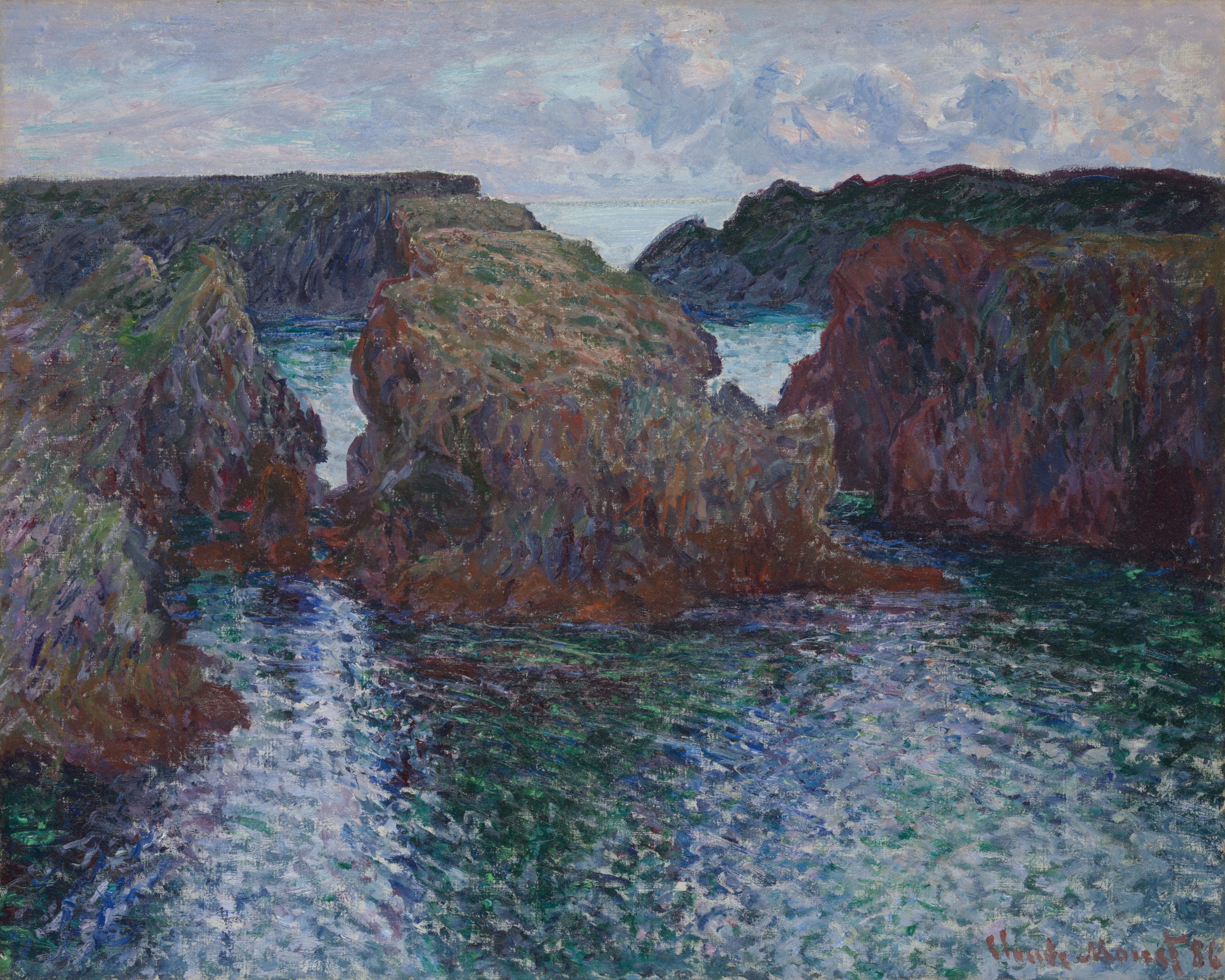
Figure 1.
Claude Monet’s Rocks at Port Goulphar, Belle-Île (1886).
Monet at various times called the views “terrifying” or “extremely beautiful” and engaged fiercely with painting them, sometimes working 14 hours per day. His statement “paint what you really see, not what you think you ought to see” (Jones 2020) are as revolutionary for sound as it was for painting. Translated into the musical world, “com-pose what you really hear, not what you think you ought to hear” would do away with a lot of music that never should have been written based on misconceptions, and compel the composer to authentically engage with sound. Not to disparage imaginative new concepts of music, but they must be based on listening deeply.
Frank Lloyd Wright’s Falling Water house was built in 1939 over a waterfall, exhibiting the architect’s approach to organic architecture. This award winning work allows the structure built for humans and nature to coexist natu-rally.
In music, bird songs and other natural sounds have often inspired composers. It may be that our ideas of melodic contours and even speech patterns have been influenced by earlier humans listening to bird sounds. Olivier Mes-siaen analyzed various bird songs in detail, and incorpo-rated them into his ensemble work Oiseaux Exotiques (1955-56). John Cage, who was influenced by Taoism, Zen Buddhism and the Journals of Henry David Thoreau “spoke of music as a model of benign ecological relations between human beings and the natural world,” His inter-est in silence furthered his idea of liberating sounds from abstract ideas about them, to let them exist as simply themselves. (Ingram 2006) His work Child of Tree consists of instructions to a percussionist to improvise with ampli-fied plant materials, such as a pod from a Poiciana tree, and the spines of a cactus, which are plucked.
He wrote in For The Birds, “I hope my music will help us in accepting the importance of ecology in music.” Other composers include Pauline Oliveros, whose Tree/Peace for violin, cello and piano explored the life cycle of a tree. Annea Lockwood has created installation sound maps that bring various points along a river into one’s listening world. John Luther Adams’s The Place Where You Listen allows the geological world of Alaska to control the instal-lation’s sound and lighting. I have also taken interest in work related to nature by Frances White, Judy Klein, and the soundscapes or soundwalks of Barry Truax, R. Murray Schafer, Hildergarde Westerkamp and Leah Barclay.
Reviewing my own work since the 1980’s, I found that at least half of my pieces have a direct connection to nature, and many others are influenced aesthetically by process-es related in some way to natural processes. I studied Buddhism in my early years, and also have practiced Tai Ch’i Chuan intermittently since 1980. In the practice of tai chi, movements which focus the mind and body in a tran-quil way are often described by natural references such as “stork spreads its wings”, “needle to the bottom of the sea,” and “stroking bird’s tail”. I have found these calming practices to increase my appreciation for the natural word, and that they facilitate finding musical insights from nature.
예술과 음악 속 자연
컴퓨터음악 작곡가가 지구에서 환경 인식과 지속가능한 삶을 증진하기 위해 할 일을 탐구하면서, 먼저 자연이 예술에 미친 특별히 흥미로운 예를 찾아보고, 이어 나의 음악작품 속 자연과의 관계를 살펴보고자 한다.
자연에서 영감받은 예술과 음악
자연에서 영감을 받은 예술로는 여러 시대에 걸쳐 자연을 사실적이거나 추상적으로 묘사하는 다양한 양식이 있다. 내가 예로 들고 싶은 것으로, 브리타뉴 남쪽 섬 드라마틱한 암석 구조와 물의 색과 질감을 잘 드러낸 모네의 그림 “벨일의 구파르 항구의 바위”가 있다.

그림 1.
클로드 모네의 “벨일의 구파르 항구의 바위” (1886)
모네는 여러 차례 이 풍경을 “끔찍하다”거나 “지독히 아름답다”고 외쳤고 열심히 그림 그리기에 몰두했으며, 때때로 하루에 열 네 시간씩 작업했다. 그가 “보아야한다고 생각하는 것을 그리지 말고 실제로 보는 것을 그려라” (Jones 2020)라고 한 말은 회화에서만큼이나 소리에 있어서도 혁명적이다. 음악세계에 맞게 번역한다면, “들어야한다고 생각하는 것을 쓰지 말고 실제로 들리는 것을 작곡하라”는 말은 오해에 근거하여 만들어지지 않았어야 할 수많은 음악을 없애고 작곡가가 진정으로 소리에 관여하지 않을 수 없게 한다. 음악의 창의적이고 새로운 개념을 폄하하려는 것이 아니라, 깊게 듣는 것을 바탕으로 하여야 한다는 것이다.
건축가, 프랭크 로이드 라이트의 낙수장Falling Water은 1939년 분수 위에 지어진 집으로, 유기적인 건축물에 대한 그의 접근 방식을 보여준다. 이 수상작품은 인간과 자연이 자연스럽게 공존할 수 있도록 설계된 구조를 갖추고 있다.
음악에서는, 새소리나 다른 자연의 소리가 종종 작곡가들에게 영감을 준다. 선율의 윤곽이나 어쩌면 언어의 패턴 같은 아이디어가 새의 노래를 들은 조상들에 의해 만들어졌을지도 모른다. 올리비에 메시앙은 여러 새의 노래를 세세히 분석하고 종합하여 “이국의 새들Oiseaux Exotiques”(1955-56)이라는 앙상블 작품을 작곡했다. 도교와 선불교, 헨리 데이비드 소로의 저널에 영향을 받은 존 케이지는 “음악을 인간과 자연세계 사이 온화한 생태학적 관계의 모델이라 말하고”, 무음silence에 대한 관심을 추상적인 개념으로부터 소리를 해방시키는 것, 그래서 단순히 그 자체로 존재토록 하는 것으로 그의 아이디어를 발전시켰다. (Ingram 2006) 그의 작품 “나무의 아이Child of Tree”는 타악기주자가 포인시아나 나무의 꼬투리나 선인장의 가시 같은 식물에 불거져나온 부분으로 즉흥연주를 하는 지시사항으로 구성되어있다
그의 저서 “새를 위하여For The Birds”에서 그는 “나는 나의 음악이 음악에서 생태학의 중요성을 받아들이는데 도움이 되길 희망한다”라고 썼다. 다른 작곡가로는 나무의 수명 주기를 탐구한, 바이올린과 첼로, 피아노를 위한 “나무/평화”를 작곡한 폴린 올리베로스가 있다. 아네아 락우드는 강을 따라 다양한 지점에서 청취한 것을 하나의 청취 세계로 만든 소리 지도 설치작품을 만들었다. 존 루터 아담스의 “당신이 듣는 그곳The Place Where You Listen”은 설치한 사운드와 조명을 조절하여 알래스카의 지리학적 세계를 경험하도록 하였다. 또한 프랜시스 화이트, 주디 클라인의 자연과 관련된 작품, 베리 트루엑스, 머레이 셰퍼, 힐더가르데 웨스터캠프나 리아 바클리의 사운드스케이프, 사운드워크에도 관심을 두고 있다.
1980년대 이후의 나의 작품을 검토해보며, 내 작품 중 적어도 절반은 자연과 직접적으로 연관이 있고, 다른 많은 작품들도 어떤 식으로든 자연의 절차와 관련된 과정을 거쳐 미학적으로 영향을 받았음을 발견했다. 내가 어렸을 때 불교를 공부했고, 1980년 이후로 태극권도 연습한 적이 있었다. 태극권 수련에서, 고요한 상태로 마음과 몸에 집중하는 운동은 종종 “황새가 날개를 편다”든가 “바늘을 바다 밑바닥에 꽂는다”든가 “새의 꼬리를 쓰다듬는” 등의 자연에서 빌려온 묘사를 하는 경우가 많다. 나는 그러한 진정시키는 연습을 통해 자연 세계에 대한 감상을 돋우고, 자연으로부터 음악적 혜안을 얻는데 도움을 받았다.
Nature-based Works
My dual interests in music and science lead me to elec-tronic and computer music in the first place, and many pieces involve natural sound, sound environments or scientific concepts from nature. The pieces I have created that relate most clearly to nature are generally in one or more of four categories: 1, based on natural sound, data or images, 2, use instruments to create sound related to natural sound, 3, use algorithms that have some connec-tion to a natural process, or 4, pieces designed as warn-ings against environmental problems.
Works Based on Natural Sound or Data
Nature has provided materials for many of my works.
Early electronic works include Occurrents (1986), an ana-log magnetic tape piece based on water sounds, created at the University of Illinois Experimental Music Studios. Later when I was studying for my D.M.A. at Columbia Uni-versity, my brother gave me a recording of Humpback whale sounds. I digitized the sounds and created a com-puter music piece “Whalesong.” Both of these pieces were based on recorded natural sound.
Sound 1. Excerpt of Whalesong (1989) by Mara Helmuth.
Bird sounds have inspired a number of my pieces. Charyl Kneevers (Zehfus) created a beautiful song about endan-gered species entitled Star Geese (1987), and I added an electronic track of geese-like sounds.
In 1997 I composed Abandoned Lake in Maine (Helmuth 2007), a stereo fixed format piece. Traveling in Wisconsin, I found a compact disk with recorded loon sounds. Upon listening I remembered hearing these sounds as a child on family vacations in the north woods, on Whitefish Lake, near Hayward. I created the piece with loon sounds using my granular sampling programs, which I will discuss in the section on algorithms. There were four very distinct orig-inal loon sounds: the hoot, the yodel, the tremolo and the call, which is heard at the beginning of Sound 2. The call and the tremolo were most conducive to creating varied textures so I tended to experiment with processing more with these sounds. In this excerpt unprocessed natural sound is heard at the beginning and end, and altered sound is in the middle.
Sound 2. Excerpt of Abandoned Lake in Maine (1997) by Mara Helmuth.
This piece alternated between natural sound segments and processed sound. I found the transitions from natural to processed sound to be easy to manage, but the transi-tions from the processed sound back to natural sound had to be handled extremely carefully to avoid awkward-ness. I attributed this unexpected difference in percep-tion to aural expectations regarding natural sound. It is not unusual to hear natural sound transformed in movies, TV or other computer music pieces. Natural soundscapes might change gradually into transformed sound worlds. Returning, however, to a totally realistic sound environ-ment in my piece required some disruption of the sense of digital media, a knock or scrape to make the abrupt change work, or a very gradual return from a processed sound into something that resembles a natural sound, to allow the listener to realign with the pure natural sound-scape again. For example, I used a windy noisy transfor-mation to easy back into the natural soundscape at the end of Sound 1. Original soundscape recordings often have several layers, such as wind noise, crickets, and loon calls, and expectations about what is in each layer and the amplitude relationships between layers, once heard, are strong. If just one layer is primarily transformed, to return to all three layers suddenly can seem jarring. Working with a return to the original soundscape after extreme alterations of natural sound can pose compositional chal-lenges. This may point to the importance of natural sound being heard as authentic, even in a context of a computer music composition where processing can be conspicuous and necessary.
This piece was overtly political in that samples of a natu-ralist’s voice were processed, as were some storm-like sounds, to create a climax warning of the threat to the natural environment of the loon.
Loonspace (Helmuth 2000) was created for Allen Otte and the Percussion Group Cincinnati, using the mainly the loon material from the previous piece. An algorithmic percussion score for unspecified instruments generated by a C program was interpreted by the group. The instru-mentalists’ convincing choices of compatible instruments and playing techniques determined the success of this piece. The acoustic instruments created bird-like sounds and other nature sounds. This piece was more a sonic environment, than a composition.
Rock Music was a sonification based on Matanuska glacier data. A geologist friend, Teresa Davis, spent much of her summer in 2004 in Alaska measuring lake sediment data. When she mentioned “grain frequencies” and other de-scriptions of lake sediment which sounded similar to granular synthesis parameters, I decided to map her data into some synthesis programs. The resulting project could only be called “Rock Music” and probably because the dual scientific/artistic approach, was particularly satisfying. The challenge here was to finding expressive and evoca-tive mappings between data and sound parameters. The potential of this technique is promising for the future, with other types of data.
자연에 기반한 작품들
음악과 과학에 대한 나의 이원적 관심으로 처음에는 전자음악과 컴퓨터음악을 접하게 되었고, 많은 작품에서 자연의 소리, 소리 환경이나 자연에서 도출된 과학적 개념을 다루게 되었다. 가장 명확하게 자연과 연관시켜 만든 작품은 일반적으로 다음 네 가지 영역 중 하나 혹은 그 이상에 속한다: 1, 자연의 소리나 데이터, 이미지에 기반한 것, 2, 악기를 사용하여 자연의 소리와 관련된 소리를 만드는 것, 3, 자연의 과정과 연관시킨 알고리듬을 사용하는 것, 4, 환경문제에 대한 경고로서 작품을 기획하는 것.
자연의 소리나 데이터에 기반한 작품들
자연은 나의 많은 작품의 소재를 제공하였다.
초기 전자음악 작품으로 일리노이대학 실험음악 연구소에서 물소리를 가지고 만든 아날로그 마그네틱 테잎 작품, “발생Occurrents” (1986)이 있다. 이후 내가 콜롬비아대학에서 박사과정을 공부할 때 내 형제가 나에게 혹등고래 소리를 녹음해주었다. 그 소리를 티지털화하여 컴퓨터음악 작품 “고래노래Whalesong”를 작곡하였다. 두 작품 모두 녹음한 자연적 사운드를 바탕으로 하였다.
음악 1. 마라 헬무트의 “고래노래” (1989) 발췌분.
새소리는 나의 많은 작품들에 영감을 주었다. 셰릴 니버스 (제퍼스)는 “스타 기러기Star Geese”(1987)라는 제목의, 멸종 위기에 처한 종에 대한 아름다운 노래를 만들고, 나는 여기에 기러기 같은 사운드의 전자음향 트랙을 추가하였다.
1997년에는 스테레오 고정매체 작품인 “메인주의 버려진 호수Abandoned Lake in Maine” (Helmuth 2007)를 작곡했다. 위스콘신을 여행하면서 아비새 소리가 녹음된 CD를 발견하였는데, 이 소리를 들으며 내가 어렸을 때 하워드 근처 화이트피쉬 호수의 북쪽 숲에서 가족 휴가를 보낼 때 들었던 소리임을 기억했다. 나는 세분화된granular 샘플링 프로그램을 써서 아비새 소리를 가지고 작곡하였고, 이의 알고리듬 부분에 대하여 논의하려 한다. 네 가지의 매우 명료한 고유의 아비새 소리가 있는데: 경적, 요들, 트레몰로, 울음으로, 음악 2의 시작부분에서 이를 들을 수 있다. 울음과 트레몰로는 다양한 짜임새를 만드는데 가장 큰 도움이 되어서, 나는 이 사운드로 보다 많은 처리를 거치며 실험하였다. 아래 발췌분에서는 가공되지 않은 자연의 소리가 처음과 끝에 나오고 중간에는 변형된 사운드가 배치되었다.
음악 2. 마라 헬무트의 “메인주의 버려진 호수” (1997) 발췌분.
이 작품은 자연의 소리 부분과 변형된 사운드 사이를 번갈아가며 진행한다. 자연의 소리에서 처리된 사운드로 진행하는 것은 작업하기 쉬웠으나, 변형된 사운드에서 자연의 소리로 돌아가는 것은 진행이 어색하지 않도록 하기 위해 극도로 주의깊게 다루어야만 했다. 이렇게 예상치못한 지각의 차이가 생기는 것이 나는 자연의 소리에 대한 청각적 기대감 때문이라 여겨졌다. 영화나 TV, 기타 컴퓨터음악 작품에서 변형된 자연의 소리를 듣는 것은 드문 일이 아니다. 자연적인 소리풍경은 점차 변형된 소리의 세계로 변화해 갈 수 있겠으나, 작품 속에서 완전히 사실적인 소리환경으로 되돌아가려면 디지털 미디어 같은 느낌을 부분 지우고, 두드리거나 긁는 것으로 갑작스러운 전환을 주거나, 변형된 사운드에서 자연의 소리와 닮은 어떤 것으로 매우 점진적으로 귀환하여야지만, 청자에게 순수한 자연의 소리풍경으로 다시 돌아온 느낌을 줄 수 있었다. 예를 들어, 음악 1의 끝부분에 자연의 소리로 쉽게 돌아오기 위해 나는 시끄러운 바람소리를 사용하여 전환하는 방법을 썼다. 원래 사운드스케이프용 녹음은 바람 소리, 귀뚜라미 소리, 아비새의 울음과 같이 여러 겹의 층이 있는 경우가 많은데, 각 층에 있는 것과 층 간의 음량 관계에 대한 기대감은 일단 한번 사용하면 강해진다. 한 층만 주로 변형되었다면, 모든 세 개의 층으로 갑자기 되돌아가는 것은 이상할 수 있다. 자연스러운 소리를 극도로 변형한 후 원래의 소리풍경으로 되돌아가는 작업을 하는 것은 작곡의 어려움이 있는 일이다. 이는 처리작업이 뚜렷하고 필수적인 컴퓨터음악 작곡의 관점에서 볼지라도, 사실적으로 들리는 자연스러운 사운드의 중요성을 시사하는 것이기도 하다.
이 작품은 자연주의자의 목소리 샘플을 처리해 마치 폭풍우와 같은 사운드로 아비새에 대한 위협적 환경에 대한 경고의 클라이맥스를 만들어낸 점에서 명백히 정치적이기도 하였다.
“아비새자리Loonspace” (Helmuth 2000)는 전작의 아비새 소리를 주소재로 사용한, 앨런 오트와 신시내티 타악기 앙상블Percussion Group Cincinnati의 연주를 위해 작곡한 작품이다. C 프로그램으로 제작된 불특정 악기를 위한 알고리듬적 타악기 악보를 타악기 그룹이 해석하여 연주한다. 연주자들이 호환가능한 악기와 연주 기법을 설득력있게 선택하면서 작품을 성공시켰다. 새소리 같은 사운드와 그외 자연의 소리를 악기로 실현시켰다. 이 작업은 작곡 작품이라기 보다 음향 환경에 더 가까왔다.
“록뮤직Rock Music”은 마타누스카강 빙하의 데이터를 소리화sonification 한 것이다. 지질학자 친구인 테레사 데이비스는 2004년 여름 대부분을 알래스카에서 호수 퇴적물 데이터를 측정하며 보냈다. 그녀가 “알갱이 빈도수grain fre-quencies”와 그외 그래뉼러 합성 요소와 비슷한 소리가 나는 호수 퇴적물에 대해 설명할 때, 나는 그 데이터를 몇몇 합성 프로그램에 적용하기로 결심했다. 이 결과의 프로젝트는 “록뮤직”이라고 밖에 이름 붙일 수 없었고, 특히 과학/예술의 이원적 접근이 만족스럽기도 했다. 여기서 해결할 문제점은 데이터와 소리의 변수 간 표현력 있으면서 감정을 일으키는 연결구도mappings를 찾는 것이었다. 이러한 기술적 가능성은 미래에, 그리고 다른 형태의 데이터에도 전도유망한 것이다.
Works with Instruments or Voice Based on Nature
Rippling, a fully improvised work, was a piece I created in 2000 for Pauline Oliveros’s Deep Listening Retreat in Hal-iburton Forest and Wildlife Reserve, in Ontario, Canada. This week-long series of deep listening sessions in nature involved many singers, and much of the work we did in-cluded vocal improvisation. Rippling was a score consist-ing of wavy, rippling lines, meant to inspire people canoe-ing in a lake to interact sonically to create a musical expe-rience. Inspired by Oliveros, the work is for either musi-cians or non-musicians. The performance of mostly voices also included the sounds of paddles in water and boats.
The Birds: An opportunity came up in the CCM composi-tion department to create a score for Concert Nova en-semble and the Cincinnati Ballet. Each person took one movement from The Carnival of the Animals by Camille Saint-Saëns, and I chose “The Birds.” I analyzed various bird samples with spectrograms, attempted to notate these sounds for acoustic string and wind instruments, and wrote a short score based on these sounds with elec-tronics.
Water Birds was a collaborative work originally created with clarinetist Rebecca Danard for clarinet, wireless sen-sor network system and electronics. The wireless sensor network system and music project was a collaboration with the Computer Science department at UC. The struc-tured improvisation used infrared sensor data from the location of the performer moving onstage to turn on or off layers of spectral delays with rtcmix~ in Max. For the score I notated fragments of music that the performer can manipulate freely. Segments of the performer’s per-formance is recorded and played back with the spectral delay. Many timing aspects are under the performer’s control. After the piece was developed, we dispensed with the sensor system, and I performed the piece taking performer location into account. The piece has been per-formed widely, and each performer has taken the piece in new directions, some with my fixed format electronic part resembling what the original patch creates. Several of the performers researched and added different bird calls to the piece. The most recent performance by An-drea Vos-Rochefort incorporates bird movements as well as sound, with a flute part performed by Elizabeth Darling. Allowing the performer to bring their own experience of nature into the piece augments the power of the piece.
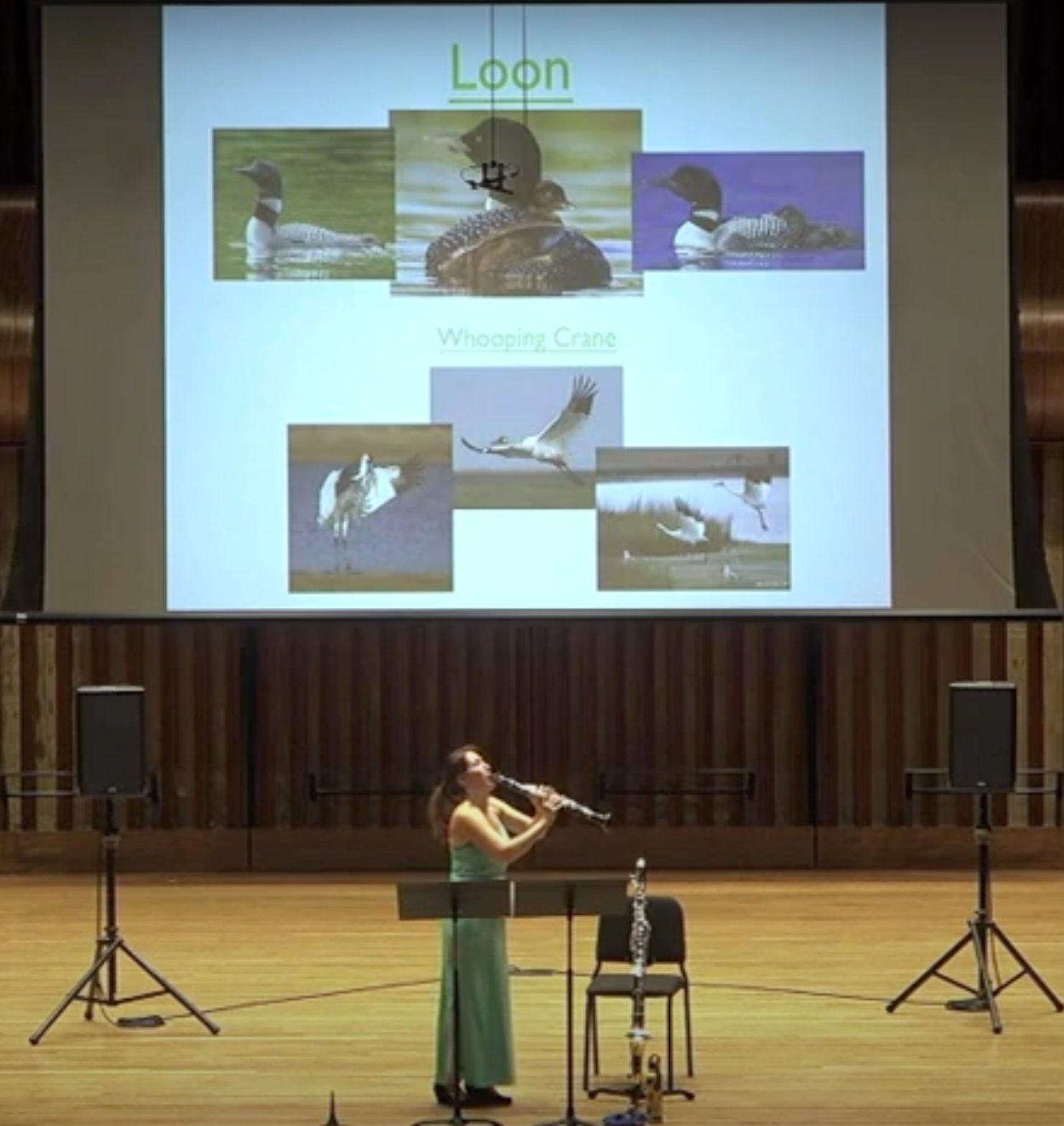
Figure 2.
Andrea Vos-Rochefort performing Water Birds, by Mara Helmuth. (video excerpt)
The butterfly has also inspired several works, although more by the symmetrical shape of its body and complex movements, than its sound. Butterfly Within for flute and fixed stereo audio was a reaction to a health crisis, and expressed my mercurial mental state at that time. The thyroid is a butterfly-shaped organ within one’s neck, and mine had a serious disease in 2006. The possibility of a one’s life being threatened makes daily experience seem much more intense and appreciated, and the quick movements of the butterfly embodied my changing emo-tions.
The flute lines range between the volatile and the serene. I algorithmically generated gestures and textures from sounds of physical models of gritty shakers and dense blowbottle layers in RTcmix to interact with the flute part, which is sometimes submerged, and sometimes emerging with fervor.
Butterfly mirrors is a structured improvisation for varying ensembles of acoustic instruments and live electronics. The score and electronic parts are related to those of Water Birds, but after a first performance by the Tornado Project, the piece was expanded for a larger ensemble, Esther Lamneck’s New Music Ensemble at New York Uni-versity. It was first performed by these 17 instrumentalists, including electric guitar, with live electronics and a spe-cial projected video of fire. The title here refers to the motivic interactions between improvising players, who might invert material in a mirror-like fashion as they hear each other play the notated fragments. The butterfly con-cept is again a visual idea of a symmetrical structure, here influencing melodic development and improvised lines.
A magical moment occurred at the beginning of the piece, when the flutist began to improvise acoustically, and after a moment her sound was picked up by two iPads nearby held by two performers. The iPad performers moved the iPads gradually into range of the microphones, gradually beginning to send a layer of spectral delays into the sound system. When the other microphones subsequent-ly became live, the sound from various instruments was processed by computer and expanded sound textures with more layers of the spectral delays was sent into the speaker system. Other performances by smaller ensem-bles have been by Ensemble Pi, SoundProof and per-formers at CCM. Each time I work with new instruments, especially in the lower registers, I am astounded by some of the sounds the spectral delays can create, with the extremely long delay times I prefer.
Onsen: Hot Springs (2019) for vibraphone and fixed me-dia had several inspirations. The first was the performer, Joseph Van Hassel, who commissioned the piece. He sent me audio and video recordings of him playing on several outdoor metal sculptures at the University of North Caro-lina, Pembroke campus where he teaches. I used these samples in the piece, with granular sampling, convolution and other processing. The other more conceptual inspira-tion was from a visit to Japan, where I was able to visit Onsen, the hot springs near Tokyo. This beautiful setting, and bathing in mineral waters, rejuvenated my energy levels intensely for three days after the visit. The bubbling sounds and sensations, the shape of a bathtub with over-hanging trees, and the peaceful energy of the location influenced the piece.
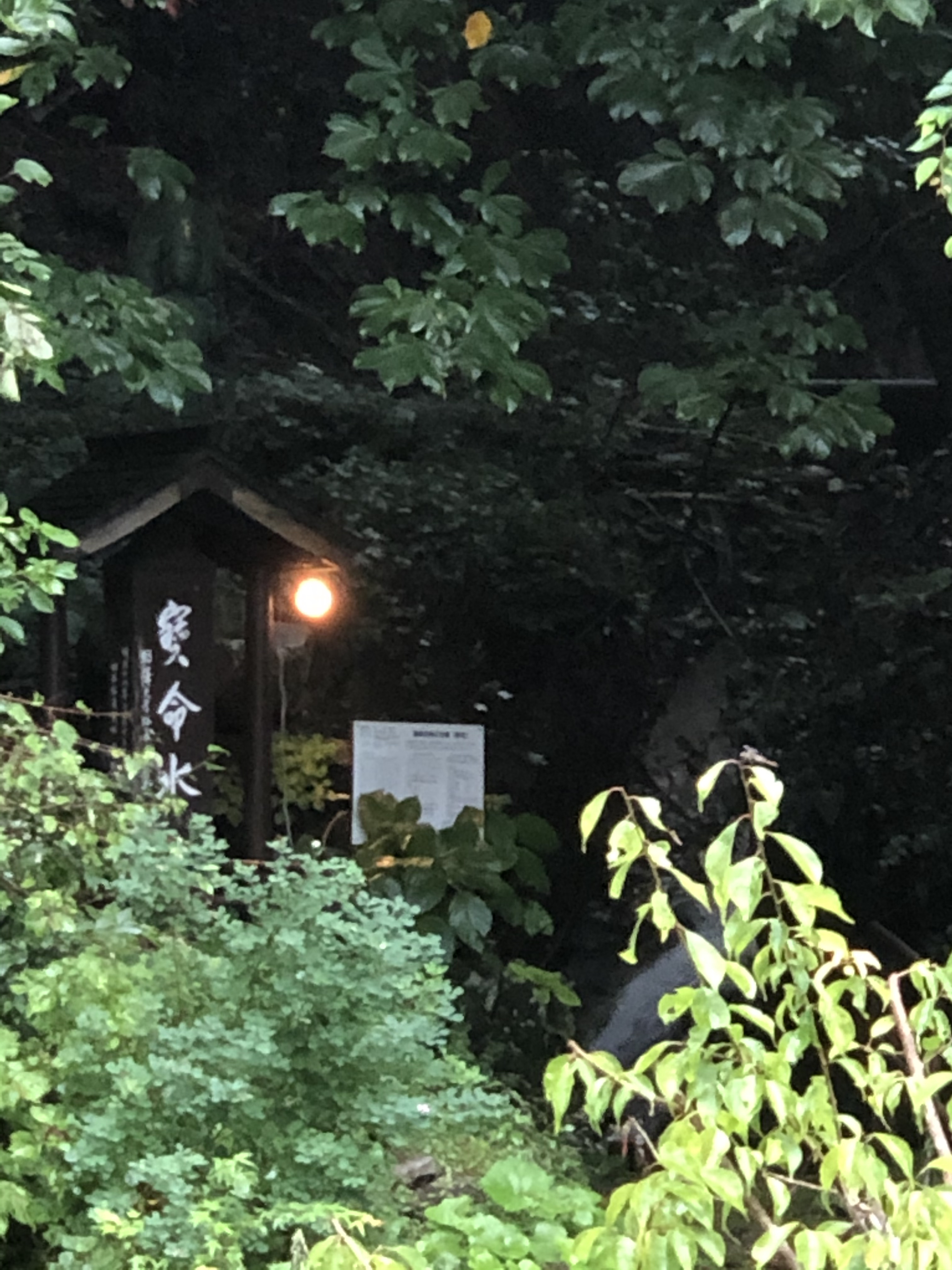 Figure 3.
Onsen. (Photo by Akira Takaoka.)
Figure 3.
Onsen. (Photo by Akira Takaoka.)
Sound 3a. Excerpt of ButterflyWithin by Mara Helmuth.
Sound 3b. Excerpt of Onsen: Hot Springs (2019) by Mara Helmuth.
자연에 기반한 악기나 목소리를 사용한 작품
“리플링Rippling”은 전체 즉흥 작품으로, 내가 2000년 캐나다의 온타리오주, 할리버톤 산림 및 야생동물 보호구역에서 폴린 올리베로스의 조용하고 깊은 청취Deep Listening Retreat 프로젝트를 위해 작곡하였다. 자연속에서 딥 리스닝을 하는 일주일간의 세션에서 여러 가수와 보컬 즉흥연주가 포함된 많은 작품이 연주되었다. “리플링”은 물결 모양의 잔물결 선으로, 호수에서 카누를 타는 사람들이 음악적 경험을 위해 음향적으로 상호작용하며 영감을 얻을 수 있도록 악보를 구성한 작품이다. 올리베로스에게서 영감을 받은 이 작품은 음악가뿐 아니라 비음악가를 위한 작품이기도 하다. 대부분의 목소리 연주 중 물과 보트에서 노젓는 소리도 포함되었다.
“새들The Birds”: 신시내티 음악대학 작곡과에서 콘서트 노바Concert Nova 앙상블과 신시내티 발레단Cincinnati Ballet을 위해 작품을 창작할 기회가 생겼다. 각 개인은 카밀 생상의 동물의 사육제The Carnival of the Animals”의 한 악장을 맡았고, 나는 “새들”을 선택했다. 다양한 새의 샘플을 스펙트럼 사진으로 분석하였고, 관현악기로 이 소리를 표현하려 악보 작업을 하였으며, 이 소리에 기반한 전자음악의 짧은 악보를 마련하였다.
“물새Water Birds”는 원래 무선 센서 네트워크 시스템과 전자음향을 위해 클라리넷주자 레베카 다나드와 함께한 협동 작품이었다. 무선 센서 네트워크 시스템과 음악 프로젝트는 신시내티대학 컴퓨터공학과과의 협업이었다. 무대 위 연주자가 이동하는 위치에 따라 적외선 센서 데이터로 맥스 프로그램의 rtcmix~로 스펙트럼 지연효과를 켜거나 끄면서 즉흥연주를 구사하도록 구성되었다. 연주자가 자유롭게 연주할 수 있도록 악보에 음악의 부분부분을 조각들로 표기하였다. 연주자가 연주한 것이 기록되고 이들이 스펙트럼 지연효과와 함께 재생된다. 많은 부분 연주자가 타이밍을 조절할 수 있도록 하였다. 작품이 완성된 이후에는 센서 시스템을 생략하고, 내가 직접 연주자의 위치를 참작하여 공연을 수행하였다. 이 작품은 널리 연주되었는데, 개인 연주자들은 각자 새로운 방향으로 연주를 끌고 갔으며, 몇몇은 초기의 패치가 만든 것과 닮은 고정매체 전자음향 파트를 활용하였다. 또다른 연주자들은 다른 새의 울음소리를 연구하여 작품에 넣었다. 가장 최근 공연에서는 엘리자베스 달링이 새의 움직임과 소리를 결합하고 그녀가 직접 플룻 파트를 연주하였다. 연주자가 그들 스스로의 자연에 대한 경험을 작품에 적용할 수 있도록 한 것이 작품의 파워를 높이게 되었던 것 같다.

그림 2.
안드레아 보슈-로드포트가 연주한, 마라 헬무트의 “물새” (동영상 발췌분)
나비도 여러 작품에 영감을 주었는데, 소리보다도 몸체와 복잡한 움직임의 대칭적 모양새가 더욱 그러하다. 플룻과 고정매체 스테레오를 위한 “버터플라이 위딘Butterfly Within”은 건강 위기에 대한 반응으로 나온 작품이었고, 당시 나의 변덕스러운 정신 상태를 표현했다. 나비 모양의 기관인 갑상선으로 나는 2006년 심각한 병을 앓게 되었다. 생명의 위협을 받는다는 것은 일상의 경험을 더욱 강렬하고 느끼게 만들었으며, 나비의 재빠른 움직임은 나의 변화무쌍한 감정을 구현해주었다.
플룻 선율은 쾌활함과 평화로움을 넘나든다. RTcmix로 모래 든 셰이커와 빡빡한 부는 병소리를 겹친 물리적 모델을 만들고 알고리듬적으로 움직임과 짜임새가 만들어지도록 하였으며, 플룻 파트가 때때로 물에 잠기고 때로는 열정적으로 떠오르며 이와 상호작용한다.
나비 거울은 어쿠스틱 악기와 라이브 전자음향으로 다양하게 구성되는 앙상블을 위하여 짜여진 즉흥연주작이다. 악보와 전자음향 파트는 “물새”의 것과 연관되었지만, 토네이도 프로젝트가 처음 공연한 이후로는 더 큰 앙상블인 뉴욕대학의 에스더 램넥 뉴뮤직 앙상블의 형태로 확대되었다. 처음에는 일렉트릭 기타를 포함한 열 일곱 명의 기악 연주자와 라이브 전자음향, 그리고 불을 활용하는 특별한 프로젝트 비디오로 공연되었다. 여기서 제목은 즉흥연주자들 간에 동기를 주고받으며 상호작용하는 것을 일컫는데, 상대 연주자가 기보된 한 조각의 음악을 연주하는 것을 듣고, 이를 거울이 비추듯 뒤집어 연주하는 것을 말한다. 이 나비의 개념은 대칭 구조를 가진 시각적 아이디어인데, 여기서는 선율의 발전과 즉흥연주 라인으로 재현되었다.
곡의 시작부분에, 플룻주자가 악기로 즉흥연주를 시작하고, 잠시 후 그 소리는 근처 두 명의 연주자가 들고 있는 두 대의 아이패드에 포착되며 마법 같은 순간이 일어난다. 아이패드 주자들은 점점 마이크 근처로 기기를 옮겨가면서, 점차적으로 스펙트럼 지연 파트가 음향시스템을 통하여 나오기 시작한다. 다른 쪽 마이크에까지 미치게 되면 컴퓨터는 다양한 악기 사운드를 처리하기 시작하고, 보다 많은 층의 스펙트럼 지연 효과가 들어간 확장된 사운드 구조가 스피커 시스템으로 전송된다. 소규모 앙상블로 연주되었던 다른 공연은 앙상블 파이, 사운드프루프, 신시내티음악대학의 연주자들이 있었다. 새로운 악기, 특히 낮은 음역대의 악기와 작업할 때마다, 스펙트럼 지연 효과로 만들어지는 사운드에 놀라움을 금치 못했고, 내가 선호하는 매우 긴 지연 시간에도 그러했다.
“온센: 온천” (2019)은 비브라폰과 고정매체를 위한 작품으로 몇 가지 영감을 받아 만들어졌다. 첫째는 이 작품을 의뢰한 연주자 조셉 반 하셀이었다. 그는 그가 가르치는 노스캐롤라이나 대학 펨브로크 캠퍼스에 있는 야외 금속 조각물 사이에서 자신이 연주하는 것을 녹화한 오디오와 비디오를 내게 보냈다. 나는 이를 작품의 샘플로, 그래뉼러 샘플링, 콘볼루션, 그외 다른 처리기술을 써 활용하였다. 다른 보다 개념적인 영감은 일본을 여행하며 온센이라는 도쿄 근처의 온천에 다녀온 것이었다. 그 아름다운 환경과 광천수 목욕은 방문한 사흘 간 나의 원기를 북돋고 젊어지게 하는 듯했다. 부글거리는 소리와 느낌, 나무가 우거진 욕조의 모양새, 그 곳의 평화로운 에너지가 작품에 반영되었다.
 그림 3.
온센. (아키라 타카오카 사진)
그림 3.
온센. (아키라 타카오카 사진)
Sound Environments Worldwide
My interest in working with natural sound became more urgent, as I explored other sound environments on dif-ferent continents, and concern about climate change increased. Travel experiences have been a compositional inspiration for the last two decades, and many of the ma-terials I have recorded have been in nature. I was aware of the changing cultures and climate and felt that the time frame for experiencing some aspects of nature might not be very long.
China in 1999 was the location of the International Com-puter Music Conference. Visiting Beijing rewakened an interest I had in Asian culture, and I resolved to return. I also met Josef Fung the conference director and director of an ensemble of traditional Chinese instrumentalists. At that point, Beijing was a sea of bicycles at big intersections, without many cars.
On sabbatical in spring of 2003, I visited several mountain parks in China and was in residence at the Sino-Nordic Arts Space (SNAS) in Beijing, directed by Fung. I recorded samples walking in three mountain parks: Hua Shan near Xi’an in Shaanxi Province, Emei Shan, near Cheng Du, one of the four Great Buddhist Mountains of China, and Huang Shan, in Anhui Province, known as China’s most beautiful mountain (Figure 4).
After these great walks I arrived in Shanghai, and the SARS epidemic was underway. I noticed the look of panic on the faces of people when I coughed, due to my aller-gies. I was advised to return home by friends, so my trip was interrupted. I was not allowed to enter Japan, the next planned visit. By the summer I was able to return to Beijing to create an installation work, Staircase of Light, in which a dancer on a stairway controls the sounds I had recorded in the parks, and their transformations. Photo-cells on each stair sent data into MaxMSP to play sounds. A related concert performance piece, China Prism, per-formed in Cincinnati, allowed the same sonic materials to be played by a dancer on a stage.
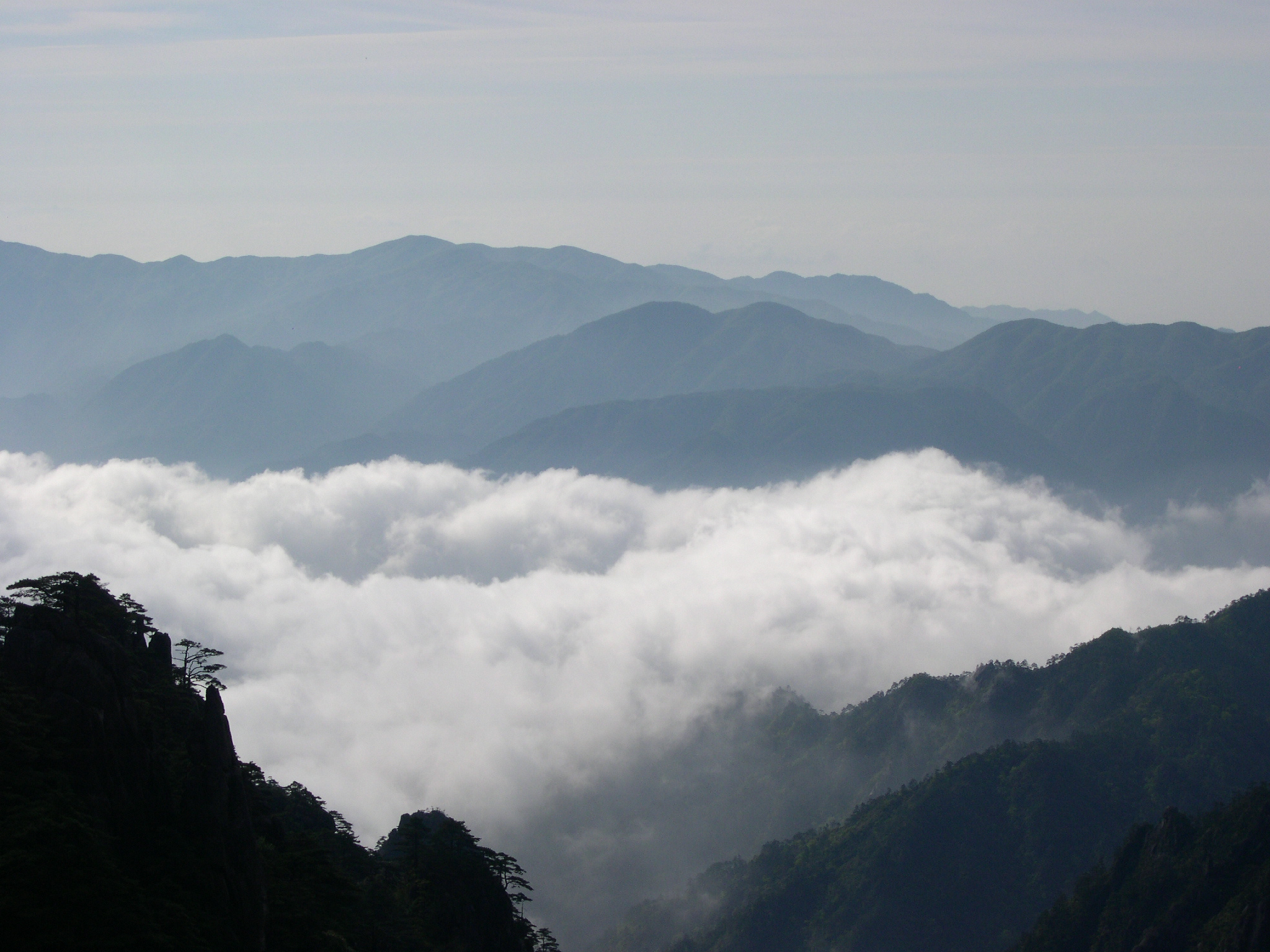 Figure 4.
“Seeing is believing” view at Huang Shan. (Photo by Mara Helmuth)
Figure 4.
“Seeing is believing” view at Huang Shan. (Photo by Mara Helmuth)
I acquired a qin (or gu-qin), an ancient 7-stringed Chinese zither on this trip in China with the help of a student at the China Conservatory of Music, with which my school has an exchange. I studied this instrument around 2005 with a teacher in Pittsburgh, and I wrote several improvi-satory pieces for my own performance with electronics. While these pieces are not directly inspired by nature, some of characters for techniques in traditional qin nota-tion are based on nature images, and I found this inspiring for composition.
I returned to China in 2007 and did additional recording, this time visiting a remote Tibetan monastery in moun-tainous Yushu, in Qinghai province. I recorded services, monastery sounds, and purchased Tibetan instruments and other items. By the time of these later trips Beijing had changed tremendously, with some of the smaller streets no longer there, and traffic congestion with many cars was amplified.
The installation resulting from my Yushu experience was called Hidden Mountain and was presented in Beijing in audio form, in a room of SNAS with marble floors and an-cient Chinese furniture. At CCM Hidden Mountain was presented in the Cohen theater with audio, video and Tibetan instruments to be manipulated by participants.
They donned a scarf with an inlaid wireless sensor, and moved around the concert hall space which affected au-dio and video. In a darkened space defined by a Tibetan rug, a recording service was heard from a temple, in which people entered ecstatic states, playing cymbals and other temple instruments.
I also recorded in temples in Japan such as Ei Hei Ji and at Tamakura, and in Korea and still have many excellent re-cordings from various trips.
Uganda’s Teach and Tour Sojourners organization invited me to visit in 2011 for an experience which included teaching in various situations and recording on safari in the country’s parks, which are outstanding places to find wildlife. In addition to many other safari recording situa-tions, I spent about an hour with a pride of lions on the last day in Queen Elizabeth park.
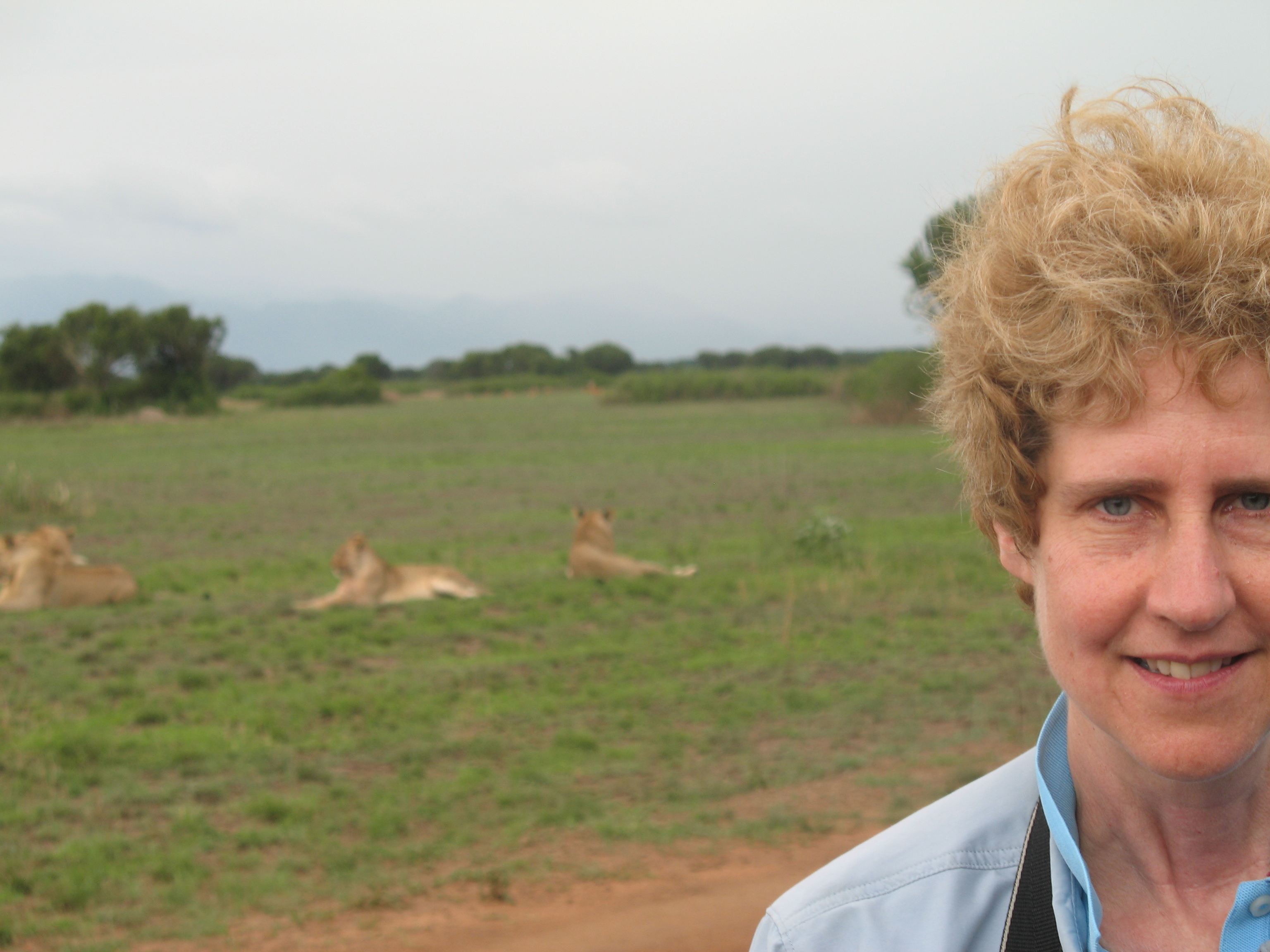 Figure 5.
With a pride of lions in Uganda.
Figure 5.
With a pride of lions in Uganda.
I created an installation Sounds of Uganda for the Giraffe Park hotel where I had stayed, and where Stawa Universi-ty courses were taught. I also created a laptop ensemble piece from Uganda (2014) in MaxMSP with rtcmix~ for several performers, based on recorded sounds of birds, frogs, a river, and hippopotamuses. A video piece from safari footage in multi-channel format also exists.
In Australia in 2016 an another extraordinary sabbatical allowed me to record sound and video at the Great Barri-er Reef, the Daintree Rainforest in Queensland, and at Uluru in the desert of the Northern Territory. My project was to investigate nature, the impact of humanity on the environment, and Aboriginal sustainable living, and rec-ord samples for composition projects. A sailing tour to an inner reef, boat tours to the outer reef, walks in the for-est, and hiking in the desert were a few of the opportuni-ties to experience and record nature. Parks are co-managed by the Aboriginal people and the government, and one might see signs as the one in Figure 8 encourag-ing one to enjoy the environment.
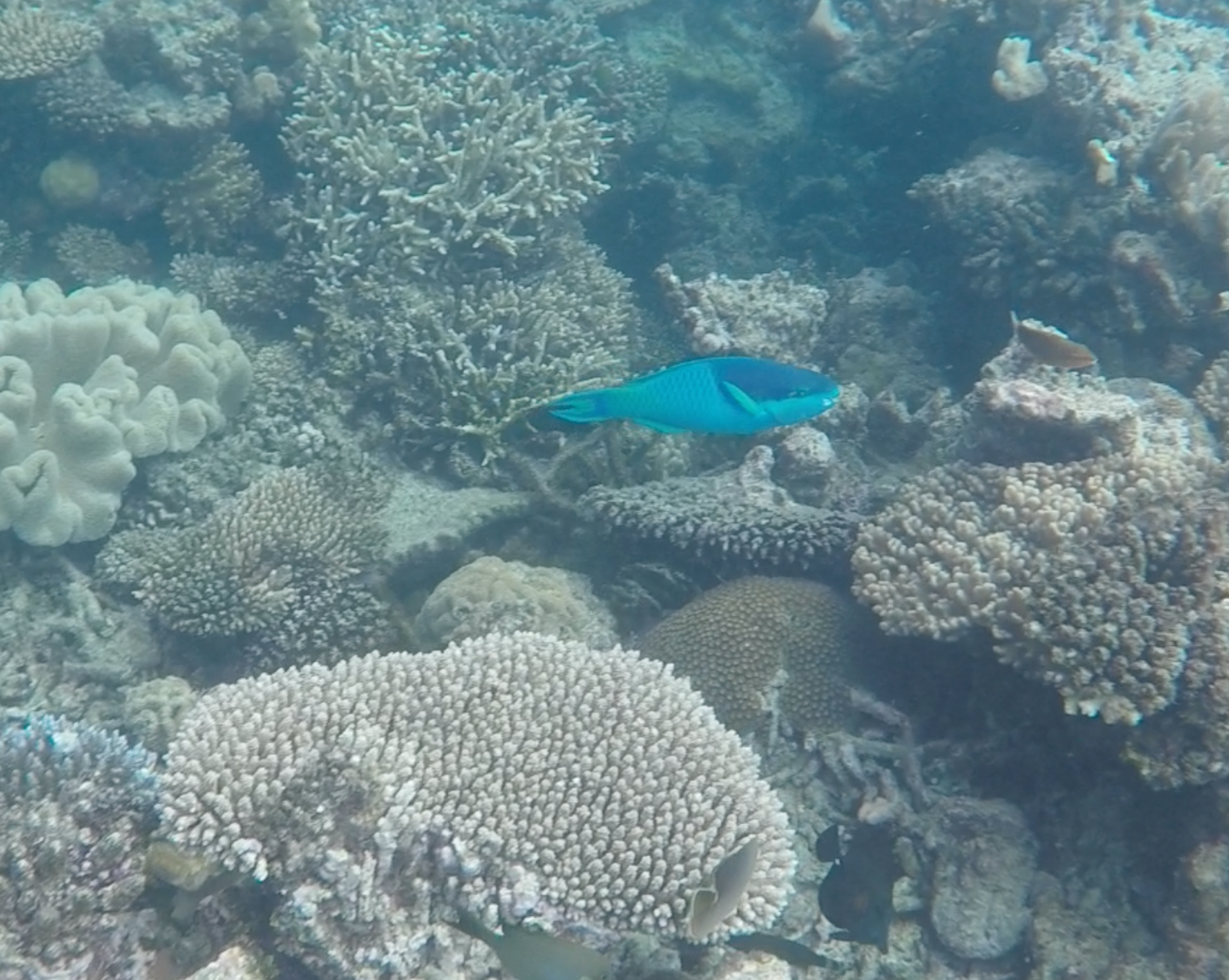 Figure 6.
Still from video taken while snorkeling in the Great Barrier Reef.
Figure 6.
Still from video taken while snorkeling in the Great Barrier Reef.
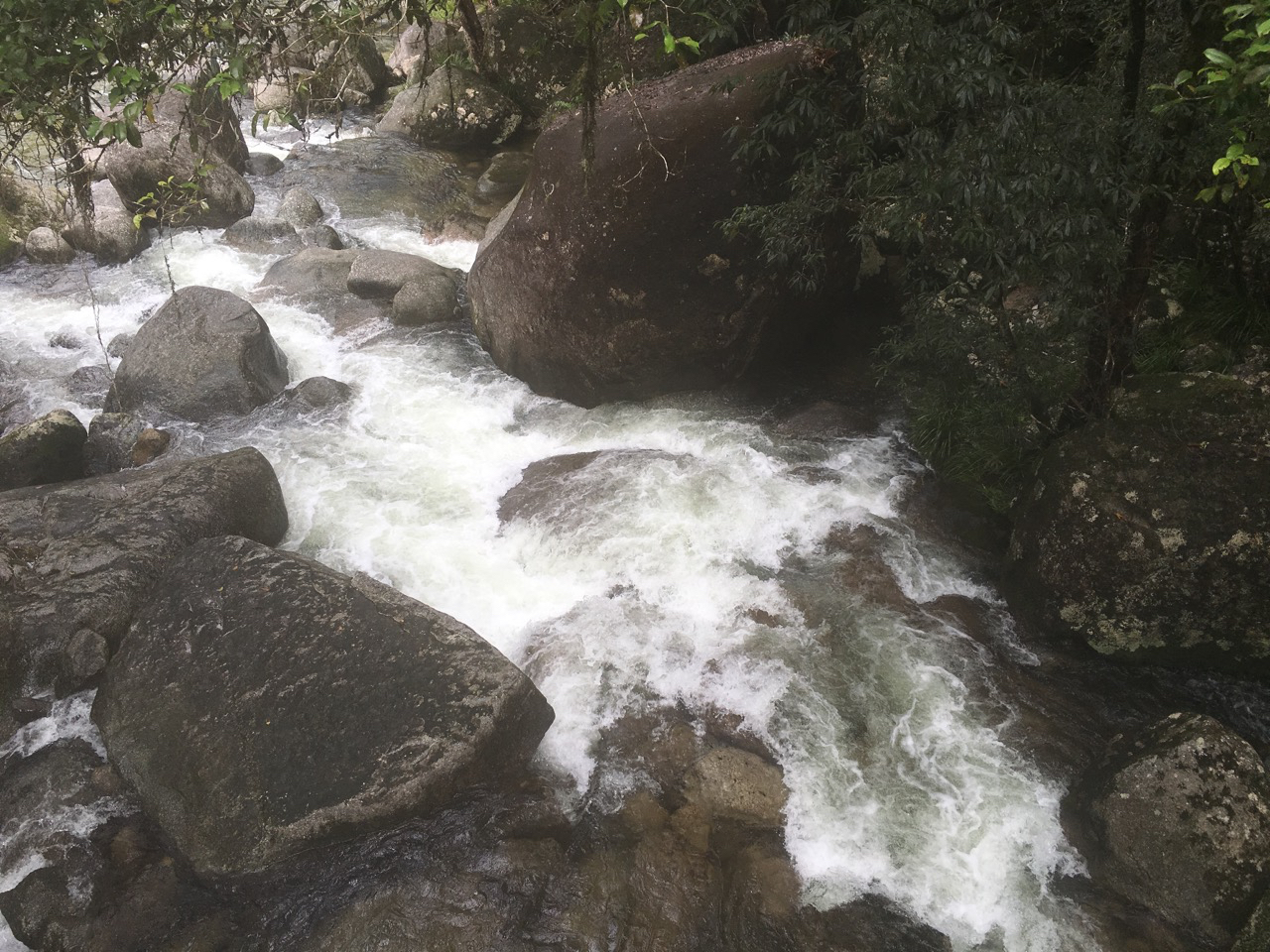 Figure 7.
Mossman Gorge in the Daintree Rainforest.
Figure 7.
Mossman Gorge in the Daintree Rainforest.
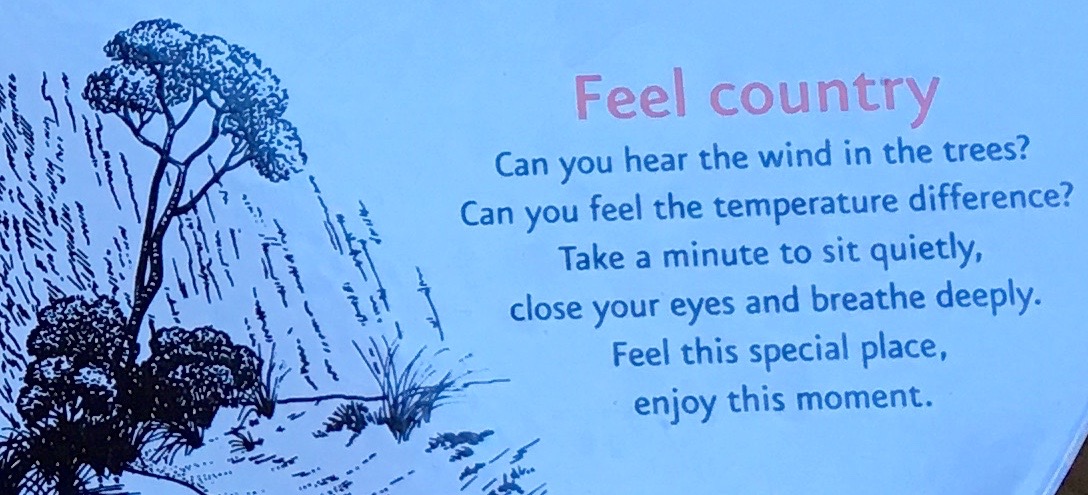 Figure 8.
A sign seen on the path at Uluru, Northwest Territory.
Figure 8.
A sign seen on the path at Uluru, Northwest Territory.
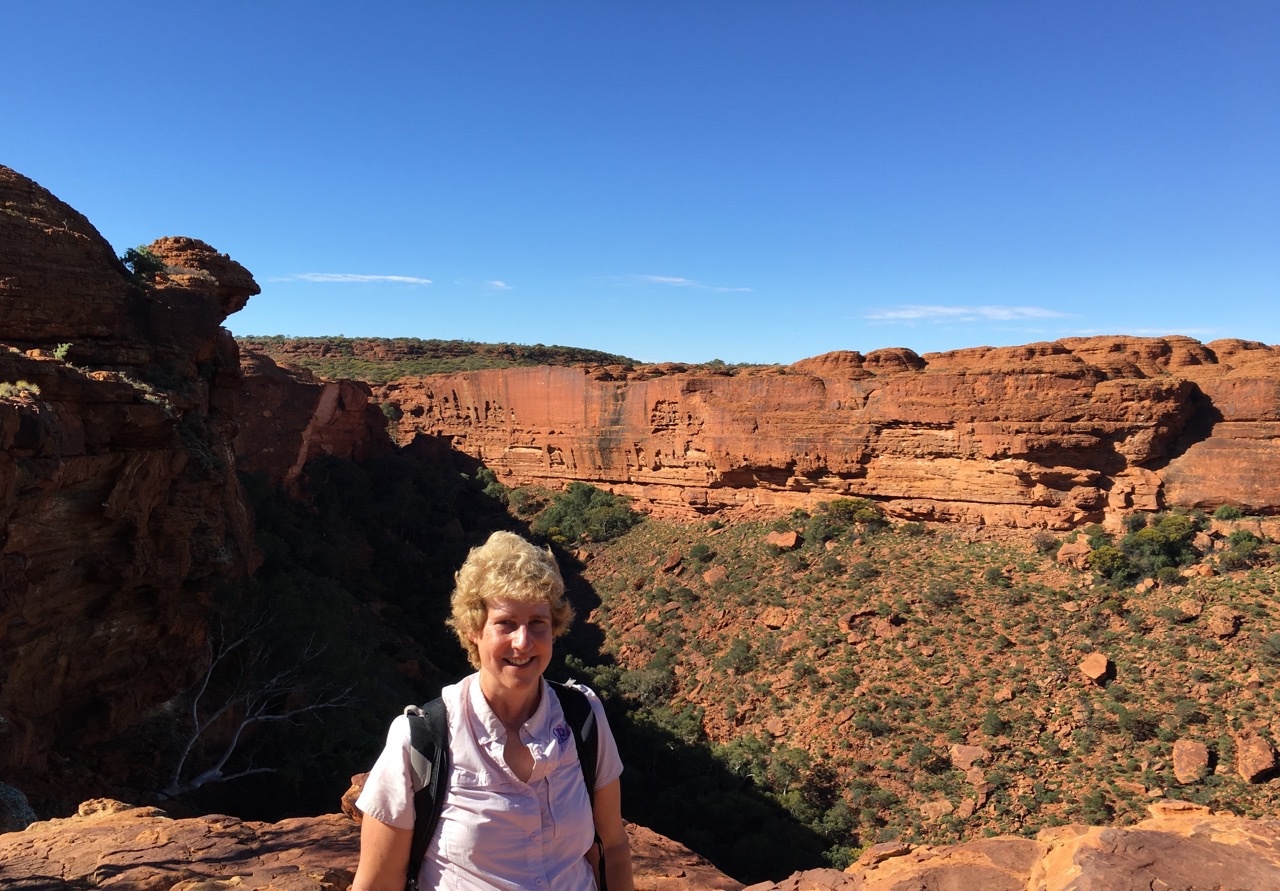 Figure 9.
Hiking in King’s Canyon, Watarrka National Park, Northern Territory.
Figure 9.
Hiking in King’s Canyon, Watarrka National Park, Northern Territory.
from Australia, a laptop ensemble piece with an expand-ed set of sounds, was one result of this unforgettable trip. In this piece there is a series of sections, which defines what categories of sounds are be drawn from. Sections are 1) water snorkeling sounds, 2) rain, 3) birds, 4) water rushing, 5) digeridoo, and 6) birds. The performer can also choose to process the sounds with RTcmix instru-ments for granular sampling, comb filters and a sweeping filter. An iPad, including its orientation data, may be used to control Max on the laptop. Intense listening is neces-sary as in any musical performance, and I advise the per-formers to spend periods of time listening to what others are playing, and then respond to the sounds. Processing is used sparingly to highlight the natural sound. Sharing the sounds I collected in this piece so that musicians can shape sound events together, was special way of honor-ing the natural sound environments and allowing others to interact with them.
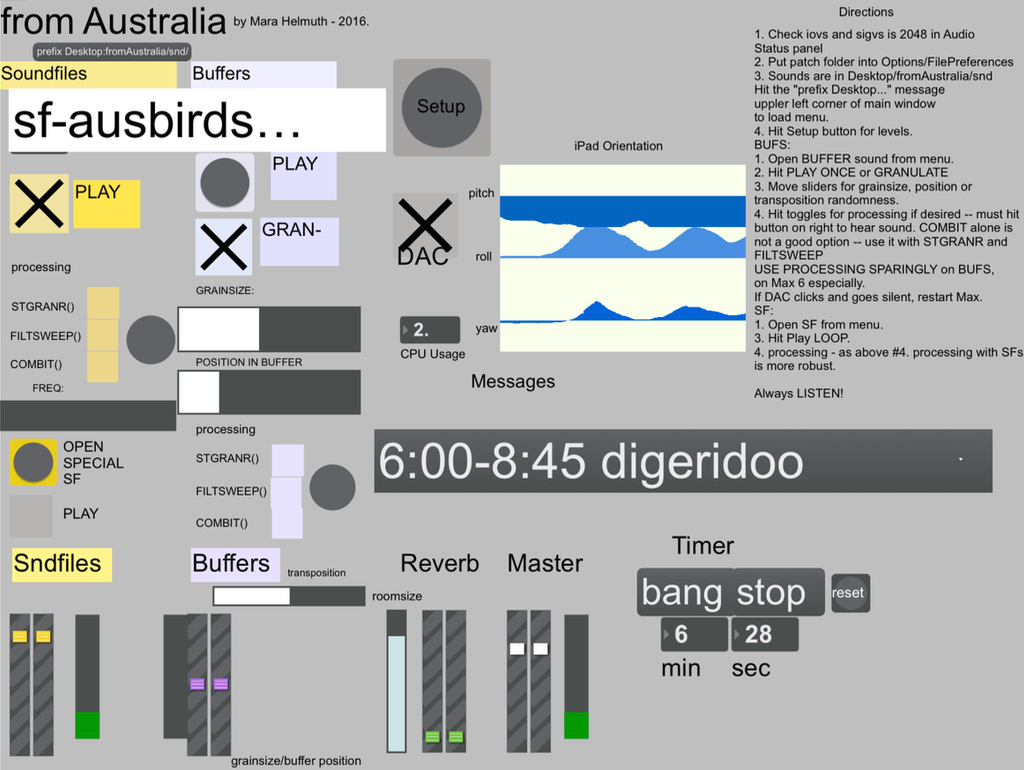 Figure 10.
from Australia Max patch.
Figure 10.
from Australia Max patch.
Sound 4. Excerpt of from Australia (2016) by Mara Helmuth.
After the Australia trip, I conceived of a Sonic Refuges project, with a concept of creating sonic refuge spaces for one to experience nature, or nature-influenced sonic environments.
세계곳곳의 소리 환경
다른 대륙의 서로 다른 소리 환경을 탐구하고 기후 변화에 대한 염려가 높아지면서, 나는 자연의 소리로 작업하고자 하는 마음이 더욱 절박하게 느껴졌다. 지난 이십여 년 간 여행한 경험이 작품의 영감이 되어주었고, 내가 기록했던 많은 자료들은 자연에 있었다. 나는 문화와 기후는 계속해서 변화하며, 자연의 면모를 경험하기에 시간은 그리 길지 않다는 것을 알고 있었다.
중국은 1999년 국제컴퓨터음악학회ICMC 개최지였다. 베이징을 방문하면서 아시아 문화에 대한 관심이 다시 일깨워졌고, 다시 들를 것을 결심했다. 나는 학회감독이자 중국 전통 기악 앙상블의 감독이기도 한 조셉 풍을 만났다. 그 당시 베이징은 차가 많지 않았고 큰 교차로는 자전거 천국이었다.
안식년이었던 2003년 봄, 나는 중국의 몇몇 산악공원을 방문했고 풍이 감독으로 있는 베이징의 북유럽예술공간 SNAS에서 지냈다. 산시성 시안 부근의 후아산, 중국 4대 불교산 중 하나인 청두 부근의 어메이산, 중국에서 가장 아름다운 산으로 알려진 안휘성의 후앙산, 이렇게 세 개의 산악공원에서 걸어다니며 샘플을 녹음했다 (그림 4).
이 대단한 산책들을 끝낸 후 상하이로 갔고, 사스 전염병이 돌고 있었다. 내가 알레르기로 기침을 하면 사람들은 공포에 질려 어쩔 줄 몰라했다. 친구들이 집으로 돌아가라는 권유에 여행을 중단하게 되었다. 다음 여행 예정이었던 일본에도 입국허가가 되지 않았다. 여름이 되고 다시 베이징으로 돌아가 설치작품인 “빛의 계단”을 만들 수 있었다. 이 작품은 댄서가 계단 위에서 내가 공원에서 녹음한 소리 및 변형된 사운드들을 조절하며 연주된다. 각 계단에 설치된 광전지가 MaxMSP로 신호를 보내고 소리가 연주되는 체계이다. 이와 관련된 콘서트 연주 작품으로 신시내티에서 선보였던 “차이나 프리즘”이 있는데, 댄서가 무대 위에서 동일한 사운드 재료를 조절하며 연주된다.
 그림 4.
“보는 것이 믿는 것이다” 후앙산 풍경. (마라 헬무트 사진)
그림 4.
“보는 것이 믿는 것이다” 후앙산 풍경. (마라 헬무트 사진)
이번의 중국 여행에서는 나의 학교 교환 학생으로 있던 중국 음악원 학생의 도움으로 고대 중국의 칠현악기인 친 (혹은 구친)을 갖게 되었다. 2005년경 피츠버그에서 한 선생님에게 이 악기를 배우며, 전자음향이 동반되는 몇몇 즉흥 작품을 만들고 내가 직접 연주하였었다. 그 작품들은 자연에서 직접적으로 영감 받은 것은 아니지만, 전통적인 친의 기보법 중 연주기법 표시말에 자연의 이미지를 기반으로 한 것들이 있었고, 이것들이 내가 작곡할 때 영감이 되어주었다.
2007년 중국으로 다시 돌아가 추가 녹음을 진행했고, 이번에는 칭하이성 위슈 산악지역에 외딴 티벳 수도원을 들렀다. 예배 의식과 수도원의 사운드를 녹음하고, 티벳 악기들과 그 외 기타 물건을 구입했다. 이때의 여행 시기에 베이징은 엄청나게 변해있었고, 작은 길들은 사라져버린 것도 많았고, 수많은 자동차로 교통혼잡이 증가했었다.
위슈에서의 경험으로 “숨은 산”이라는 설치작품을 만들었고, 베이징의 북유럽예술공간SNAS의 대리석 바닥에 고대 중국 가구로 장식된 한 공간에서 오디오 형태로 발표되었다. 신시내티대학에서는 참여자들이 직접 조절하도록 된 오디오와 비디오, 티켓 악기를 써서 코헨 극장에서 “숨은 산”을 선보였다.
그들은 무늬가 새겨진 무선 센서가 달린 스카프를 두르고, 연주홀 공간을 이리저리 이동하며 오디오와 비디오가 움직이게 하였다. 티켓 양탄자라 불리우는 한 으슥한 공간에서, 사원 풍경의 소리가 녹음된 사운드를 들으며 사람들은 황홀한 경지에 이르기도 하고 심벌즈나 다른 사원 악기들을 연주하기도 한다.
에이헤이사나 타마쿠라에서와 같은 일본의 사원이나 한국에서도 녹음을 하였는데 아직도 다양한 여행들에서 얻은 다수의 훌륭한 녹음본을 보유하고 있다.
우간다의 교육및여행승객 기구로부터 초대받아 2011년 방문했고, 다양한 상황에서의 교육을 경험하거나 야생동물을 잘 볼 수 있는 지역의 공원에서 사파리 관련 녹음을 수행하였다. 많은 다른 사파리 녹음 상황 말고도, 나는 퀸 엘리자베스 공원 방문 마지막 날 한 무리의 사자들과 한시간 정도를 함께 보냈다.
 그림 5.
우간다에서 한 무리의 사자들과 함께.
그림 5.
우간다에서 한 무리의 사자들과 함께.
내가 스타와대학에서 수업을 진행하며 머물렀던 기린공원 호텔을 위해 “우간다의 소리”라는 설치작을 만들었다. 또한, 새와 개구리, 강, 하마를 녹음한 소리를 기반으로 몇몇 연주자와 rtcmix~를 활용한 MaxMSP로 노트북 앙상블 작품 “우간다로부터” (2014)를 작곡하기도 하였다. 사파리 장면이 담긴 다채널 비디오 클립도 있다.
호주는 2016년 또다른 특별한 안식년을 맞아 방문했고, 그레이트배리어리프, 퀸즈랜드의 데인트리 열대우림, 노던 테리토리의 사막에 있는 울룰루에서 사운드와 비디오를 기록하였다. 자연과 환경에 끼친 인류의 영향, 원주민의 지속가능한 삶에 대하여 조사하고 작곡에 쓸 샘플을 녹음하는 것이 나의 프로젝트였다. 내부 암초로 항해 투어, 외부 암초로 보트 투어, 숲 속 산책, 사막 하이킹 등이 몇 안되는 내가 자연을 경험하고 녹음할 수 있는 기회였다. 공원은 원주민 사람들과 정부가 공동으로 관리되고 있었으며, 그림8에서와 같이 주변 환경을 즐기도록 표지판이 도움을 주기도 한다.
 그림 6.
그레이트배리어리프에서 스노클링 중 찍은 비디오 스틸컷.
그림 6.
그레이트배리어리프에서 스노클링 중 찍은 비디오 스틸컷.
 그림 7.
데인트리 열대우림의 모스만 협곡.
그림 7.
데인트리 열대우림의 모스만 협곡.
 그림 8.
노스웨스트 테리토리, 울루루 길에서 본 표지판.
그림 8.
노스웨스트 테리토리, 울루루 길에서 본 표지판.
 그림 9.
노던 테리토리, 와타르카 국립공원 킹스캐년에서 하이킹.
그림 9.
노던 테리토리, 와타르카 국립공원 킹스캐년에서 하이킹.
“호주로부터”는 사운드 확장 시스템이 첨가된 노트북 앙상블 작품으로, 이번 잊지못할 여행의 결과물이었다. 이 곡에는 각 섹션의 사운드가 어디서 왔는지 범주를 정의한 섹션들의 시리즈가 있는데, 1) 스노클링 물소리, 2) 비, 3) 새들, 4) 세차게 흐르는 물 5) 디제리두 [호주원주민 관악기], 6) 새들이 그것이다. 연주자는 그래뉼러 샘플링, 콤필더, 스위핑필터 기술을 구현하는 RTcmix 프로그램으로 처리내용이나 사운드 등을 조절한다. 방향성 데이터를 장착한 아이패드로 노트북에서 Max를 제어할 수 있다. 여느 음악 공연에서처럼 경청에 집중하여야 하고, 연주자들에게 다른 연주자가 연주하는 것을 듣는데 어느 정도의 시간을 할애한 후 들은 것을 반영해야 한다고 조언한다. 드물게는 자연의 소리를 강조할 목적으로 처리과정을 가할 때도 있다. 내가 수집한 소리들을 공유하여 이 작품의 다른 음악가들이 다같이 청각적 이벤트를 만들어나가게 한 것이, 자연에 의한 소리 환경을 존중하면서 다른 이들과 서로서로 상호작용할 수 있도록 해준 특별한 방법이었다.
 그림 10.
“호주로부터”의 맥스 패치.
그림 10.
“호주로부터”의 맥스 패치.
음악 4. 마라 헬무트의 “호주로부터” (2016) 발췌분.
호주 여행을 마친 후, 나는 자연을 경험하거나 자연의 영향을 받은 청각 환경을 경험할 수 있는 음향적 피난처 공간에 대한 아이디어를 가지고 소닉 레퓨지 프로젝트를 구상하였다.
Using Algorithms Connected to Nature
Composition micro-level and macro-level algorithms have also allowed me to create structures that have various relationships with nature.
Islands (1988) was an algorithmic piece with a C-program generated CSound score. The program created a struc-ture of grouped frequency modulation sound events with with complex envelopes. The piece was named by Brad Garton, my teacher at Columbia, who said the sounds re-minded him of islands as he drove home through the night New Jersey fog. While I had approached the compo-sition abstractly, with a four-level logical process to gen-erate materials of various types, the results sounded analogous to a sonification of geological formations.
Granular synthesis first caught my attention in the next year, inspired by Barry Truax’s Riverrun and the formal-ized music of Iannis Xenakis. I created several instruments in the Cmix music programming language that would cre-ate gestural stochastic granular phrases, either by synthe-sis or granular sampling. The first piece I did with the syn-thesis instrument was called Song for Earth Day, as I found myself finishing the piece in the Columbia studio around Earth Day, 1990. While I was unable to take part in Earth Day events, I was delighted to create some natural sound-ing thunder and water sounds using the stochastic pa-rameters of my new instrument. The complexity of the probability-controlled grain parameters approaches the complexity of situations in nature, such as river water rushing against uneven rocks.
Sound 5. Excerpt of For Earth Day (1990) by Mara Helmuth.
Extensions of these granular synthesis programs have allowed me to continue to create diverse sound worlds in many of my pieces in different genres. When processing the sounds of instruments, as well as in synthesis, the qualities of the resulting sounds are different from tradi-tional musical phrases in that gradual changes, types of transformations and gestures tend to be more important than patterns of pitches, melodies, harmonies, or metrical structures. The timbral gestures in my granular synthesis works may have more commonalities with natural sound, even if not created from natural sound samples. This as-pect may also free the music from some expectations listeners could have with instrumental music.
Environmental warning pieces include the previously mentioned Abandoned Lake in Maine with the threaten-ing climax warning of habitat loss. All Alarms Sounding (2017) was written for two pianos and electronics. In 2016 I had spent several days snorkeling in the outer and inner reefs of the Great Barrier Reef near Port Douglas and Shute Harbour, Queensland. This reef is the world’s largest organism, and full of fascinating features and fish. In the year of my visit, however, 22% of Australia’s Great Barrier Reef died because the ocean temperature was too warm. A person in Queensland told me that his shoes melt on the street in summer. The sense of urgency about the degrading environmental situation triggered alarms in my mind as well as in the news. Program notes for this work read, “Alarms go off every year, every month, about the consequences of climate change…. Complex systems like the reef, the rainforest and the mangroves evolved over millennia to coexist, the wildlife in an intricate bal-ance with their environment. Fast changes are not some-thing that can be easily accommodated by evolution. Something may survive future climate change, but it may not be us, or life as we know it.”
I had resolved by this point to make environmental awareness a primary focus of my work.
Endangered Sound is a piece created for network per-formance using RTcmix on Internet2 for the Network Mu-sic Conference at Stony Brook University in 2018. Each performer was instructed to find sounds they considered “endangered”, such as that of a threatened species. Sounds were exchanged between remote locations of CCM in Cincinnati and Stony Brook University, NY. As I have found in previous sound exchanges of this kind, the intense listening required with only audio connections, and no video, no visual cues between performers, actual-ly enhances the improvisational experience. Performers actually had trouble finding “endangered sound” from threatened species, and I ended up providing samples. Both of the above pieces highlight threats to our envi-ronment, and my intention was to increase awareness of these issues.
Collaborations with Esther Lamneck, virtuoso performer and also a composer who has co-composed several works with me. All of these pieces have extensive use of granu-lar synthesis algorithms which create gestural forms which are in my mind related to geological formations or the motions of wind and water. Her improvisatory and virtuosic performance is very compatible with these algo-rithmically generated sounds. Our first interactive work for the Hungarian tárogató wind instrument and live elec-tronics, Irresistible Flux, was based on an old folk song. Two more recent works are more directly based on envi-ronmental ideas. Breath of Water, for clarinet and stereo fixed media was influenced by the sight and sounds of a group of humpback whales I saw on a windy boat trip from Great Barrier Reef’s outer reef Opal Reef to Port Douglas, as well as Lamneck’s compelling subharmonic sounds. The two sets of sounds, whales and subharmonics, had unexpected commonalities that allowed them to be connected in the piece easily.
Sound 6. Excerpt of Breath of Water (2016) by Mara Helmuth and Esther Lamneck.
Sound Dunes (Helmuth 2019), a more recent collabora-tive composition, is based on tárogató phrases and my digital transformations, which we realized created dune-like sound structures with curving contours and granular textures. A new multichannel immersive version is scheduled to be premiered at the Sonorities Festival in Belfast, 2022.
Sound 7. Excerpt of Sound Dunes (2019) by Mara Helmuth and Esther Lamneck.
자연과 연관된 알고리듬 사용하기
미시적 차원과 거시적 차원의 알고리듬 작곡으로 자연과 다양한 관계를 갖는 구성을 만들 수 있다.
“섬” (1988)은 CSound로 생성한 C-프로그램으로 만든 알고리듬적 작품이다. 이 프로그램은 복잡한 엔벨로프로 주파수 변조가 그룹지워진 음향적 이벤트를 구성하도록 되어있다. 이 작품은 콜롬비아에 있을 때 나의 선생, 브래드 가르톤이 이름지어주었는데, 뉴저지의 밤안개를 뚫고 집으로 운전해 갈 때 이 곡의 소리가 섬을 생각나게 했다고 말했다. 네 단계의 논리적 과정으로 다양한 스타일의 재료들을 만들 생각으로 이 작곡에 추상적으로 접근했었지만, 그 결과는 마치 지질학적인 형성과정을 소리화한 듯한 것이었다.
그래뉼러 합성은 그 다음 해 배리 트루엑스의 “리버런Riverrun”이나 이아니스 크세나키스의 포멀라이즈드 뮤직에 감동받으며 처음으로 나의 관심을 끌게 되었다. 합성 기술이나 그래뉼러 샘플링 기술을 사용하여, 움직임이 있으면서 확률론을 활용한 그래뉼러 악구를 생성할 수 있는 Cmix 음악 프로그래밍 언어로 몇 개의 악기 프로그램을 만들었다. 합성 악기로 처음 만든 작품은 “지구의 날을 위한 노래”라는 곡인데, 1990년 지구의 날 즈음 콜롬비아 스튜디오에서 완성하였다. 지구의 날 행사에는 참가할 수 없었지만, 나의 새 악기로 확률적 변수를 활용하여 만든 자연스러운 음향의 천둥소리와 물소리에 기뻐했다. 작은 조각적 요소들을 확률로 조절하며 생성되는 복잡함이, 고르지 않은 암석에 부딪히며 흐르는 강물과 같이 자연의 복잡한 상황에 비슷한 정도에 다다를 수 있게 해준다.
음악 5. 마라 헬무트의 “지구의 날을 위한 노래” (1990) 발췌분.
이러한 그래뉼러 합성 프로그램의 발전과 확장 덕분에 다양한 장르의 많은 나의 작품들에서 여러 소리 세계를 계속 창조해낼 수 있었다. 기기의 사운드를 처리할 때뿐 아니라 합성할 때에도, 결과적으로 나타나는 사운드의 수준이 음고나 선율, 화성, 시간적 구성의 패턴보다 점진적인 변화과정이나 변형되고 움직이는 행태를 더욱 중요시한다는 점에서 전통적인 음악과는 다르다. 나의 그래뉼러 합성 작품 내 음색의 모양새는 자연의 소리를 샘플로 쓰지 않은 것이라도 자연의 소리와 공통점이 더 많을 것이다. 이러한 점은 관객이 기기 음악에 거는 기대감으로부터 어느 정도 자유로와지게도 한다.
환경 경고 작품은, 서식지 손실에 대한 위태로움이 극에 달했다는 경고로 앞서 언급했던 “메인주의 버려진 호수”가 있었다. “모든 경고의 울림” (2017)은 두 대의 피아노와 전자음향을 위해 쓰여진 곡이다. 2016년 퀸즈랜드에서 포트 더글라스와 슈트 항구 근처 그레이트배리어리프의 내외부 암초에서 스노클링을 하며 며칠 보냈었다. 이 암초는 세계에서 가장 큰 유기체로, 매혹적인 특징과 물고기로 가득하다. 그러나 내가 방문했던 해에 호주 그레이트배리어리프의 22%가 해수 온도가 너무 올라서 죽었다. 퀸즈랜드에 사는 사람이 말하길 여름에는 거리가 너무 뜨거워 신발이 녹는다고 했다. 이런 열악한 환경 상태에 대한 위기감이 뉴스는 물론이고 나의 마음에도 경고의 울림이 느껴졌다. 이 곡의 프로그램 노트에 따르면, “기후 변화의 후폭풍에 대해 알람이 매년, 매달 울린다… 산호초나 열대우림, 맹그로브숲 같은 복잡한 시스템은 환경과 복잡하게 뒤얽혀 균형을 이루며 사는 야생동물과 함께 공존하기 위해 수천년간 진화해왔다. 급격한 변화는 진화라는 것으로 쉽게 수용될 수 있는 것이 아니다. 어떤 것은 미래의 기후 변화에도 살아남을 수 있을지 모르지만, 알다시피 우리나 다른 생명들은 아닐 수 있다.
나는 이 시점에 환경 인식을 나의 작품의 주요 주제로 삼기로 결심했다.
”멸종위기의 소리”는 2018년 스토니부룩 대학에서 열린 네트워크 음악 학회 공연을 위해 인터넷2에 RTcmix를 사용한 네트워크 퍼포먼스 작품이다. 각 연주자는 멸종위기에 처한 종의 소리와 같이 “위기이 처한” 것으로 여겨지는 소리를 찾아야 한다. 신시내티와 뉴욕의 스토니부룩 대학 간 떨어진 위치 사이에서 사운드를 교환하였다. 이전의 이러한 사운드 교환작업 중 알게 된 것이, 연주자 간 비디오나 시각적 정보가 전혀 없기 때문에 오디오 연결에만 의존해야 하고 듣는 것에 더욱 집중하게 되며, 이는 실제로 즉흥연주 경험을 향상시킨다는 것이다. 사실상 연주자들은 직접 멸종위기종에 의한 “위기에 처한 소리”를 찾는데 어려워했고, 결국 내가 샘플을 제공하였다. 위의 두 곡 모두 우리의 환경에 위협이 있음을 표현하였고, 이 이슈에 대한 인식을 높이는 것이 내가 의도한 것이었다.
에스더 램넥과의 콜라보, 그녀는 나와 몇몇 작품을 공동작업 한 명연주자 겸 작곡가이다. 콜라보로 만든 모든 작품은, 내가 생각하기에 지질학적 형성과정이나 바람과 물의 움직임과 관련되어 있는 제스쳐의 형태를 띄고 있으며, 그래뉼러 합성 알고리듬을 높은 비중으로 활용한 것들이다. 그녀의 즉흥적이며 기교적인 연주는 이렇게 알고리듬으로 생성된 소리와 꽤 잘 어울린다. 헝가리 민속 관악기인 타로가토와 라이브 전자음향을 위한 “저항할 수 없는 흐름”이 우리의 첫 합동 작품이었고, 오래된 한 민요를 가지고 만들었다. 최근 두 개의 작품은 보다 직접적으로 환경적 아이디어에 근거를 두었다. 클라리넷과 스테레오 고정매체를 위한 “물의 숨결”은 그레이트배리어리프의 외부암초인 오팔 리프에서 포트 더글라스까지 바람이 많이 부는 보트 여행을 하면서 본 혹등고래 무리의 광경과, 램넥의 매력적인 저배음subharmonic 사운드에 영향을 받아 만들어졌다. 고래와 저배음, 두 소리는 예상치않게 작품에서 쉽게 연결될 수 있는 공통점이 있었다.
음악 6. 마라 헬무트와 에스더 램넥의 “물의 숨결” (2016) 발췌분.
보다 최근의 콜라보 작품인 “소리 사구” (Helmuth 2019)는 타로가토의 선율악구와, 곡선으로 움직이는 윤곽선과 조각조각 세분화된 짜임새로 모래언덕과 같은 소리 구성을 이루게 해준 나의 디지털 변형기술을 바탕으로 하였다. 이의 새로운 다채널 몰입형 버전이 2022년 벨파스트에서 열리는 소노로티즈 페스티벌에서 초연될 예정이다.
“Space” Pieces: Apart or From Nature?
Several of my compositions seem at first to be almost op-posed to environmental music, coming from abstract ide-as of space. Of course, space is apart from earth, but not apart from a cosmic view of nature.
Dragon of the Nebula (Helmuth 2020) was written in 1992 in response to the Gulf War, and reminded me of an image of a galactic nebula. It was composed with the same granular synthesis instrument as Song for Earth Day, but has more precisely defined granular gestures, some with “metallic” sounds (grains with long durations in dense frequency bands) or noisy granular bands. While these sounds may seem to have little to do with nature, actually the opening noisy bands of sound smoothly descending can resemble wind-like phrases, while the fierce “metallic” dragon gestures might sound related to metal percussion sounds. Many of the sounds based on probabilities rising or falling in undulating or twisting patterns, emulate the movement of water or clouds.
Expanding Space, for tuba and computer was composed for my colleague Timothy Northcut, tubaist, based on a concept of the increasing space between people in the digital age, as well as the astronomical idea of expanding space. Again, while the original idea seems remote from life on earth, and the lengthy algorithmically mixed third and final section has an other-worldly feel, the acoustical realities of the magnificent F and C tubas, which were recorded in the underground CCM parking garage with a 10-second reverberation time, ground this piece in an earthly context.
Opening Spaces, which will be seen on the conference, is based on a Menger sponge fractal and realized in video with Blender and Unity. The structure is suspended in space, and becomes more complex as the viewer moves among various versions and parts of the fractal. While the idea is quite abstract, the sounds are made from RTcmix instruments based on physical models of acoustic instru-ments, a Helmholtz resonator (MBLOWBOTL()) usually in simple harmonic ratios, and a 2D Mesh instrument (MMESH2D()). Another aspect of the video which is influ-enced by nature is the particle systems which emits flecks of shininess that pass through the structure, in synchrony with the sounds. The opposition of the precisely config-ured abstract structure in space with the earthy quality of the original sounds, and the spontaneous movements of the particles, reminding one of snow or the fluffy wind-born seeds of trees gave me a surreal but surprisingly nurturing feeling.
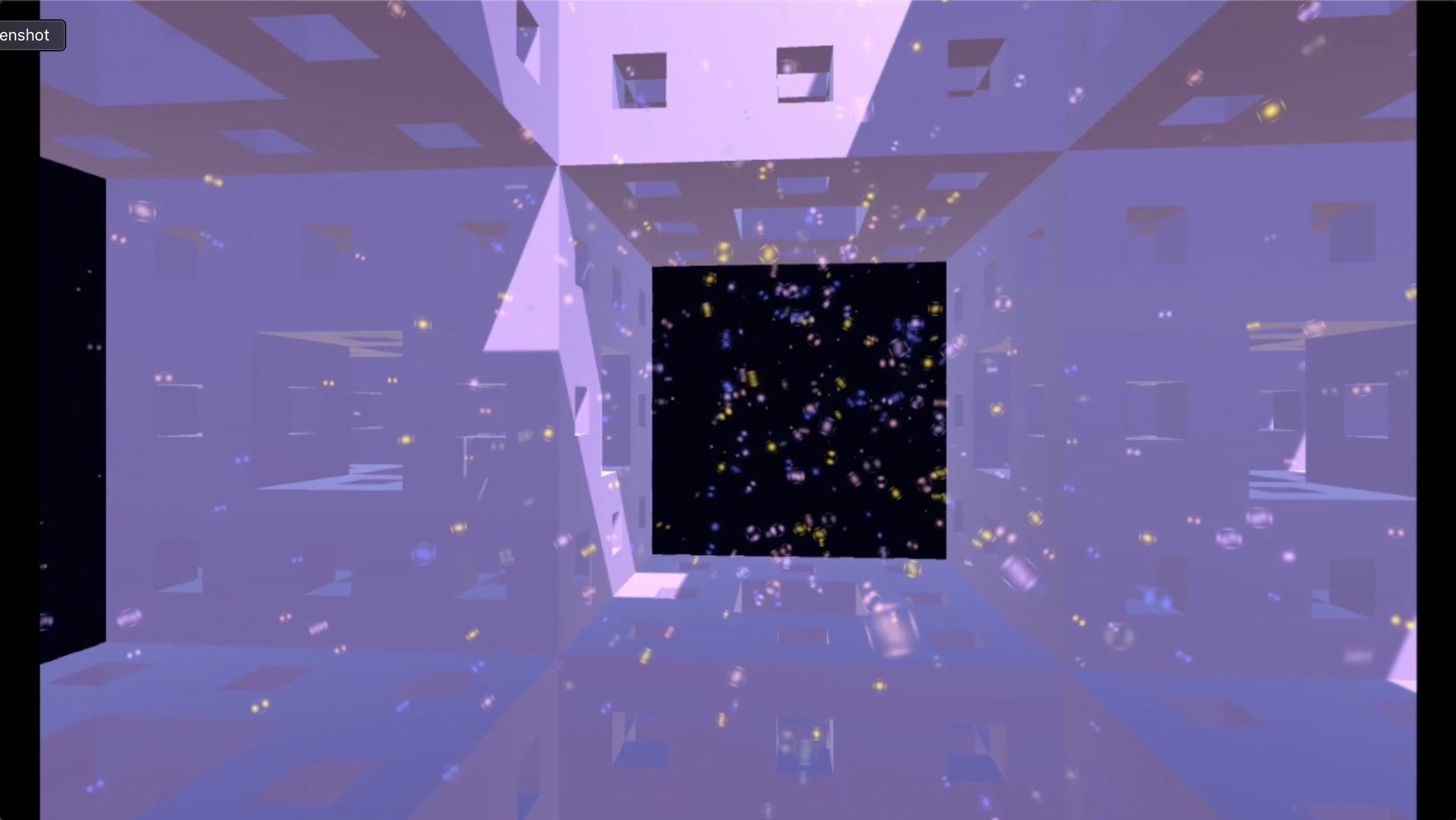
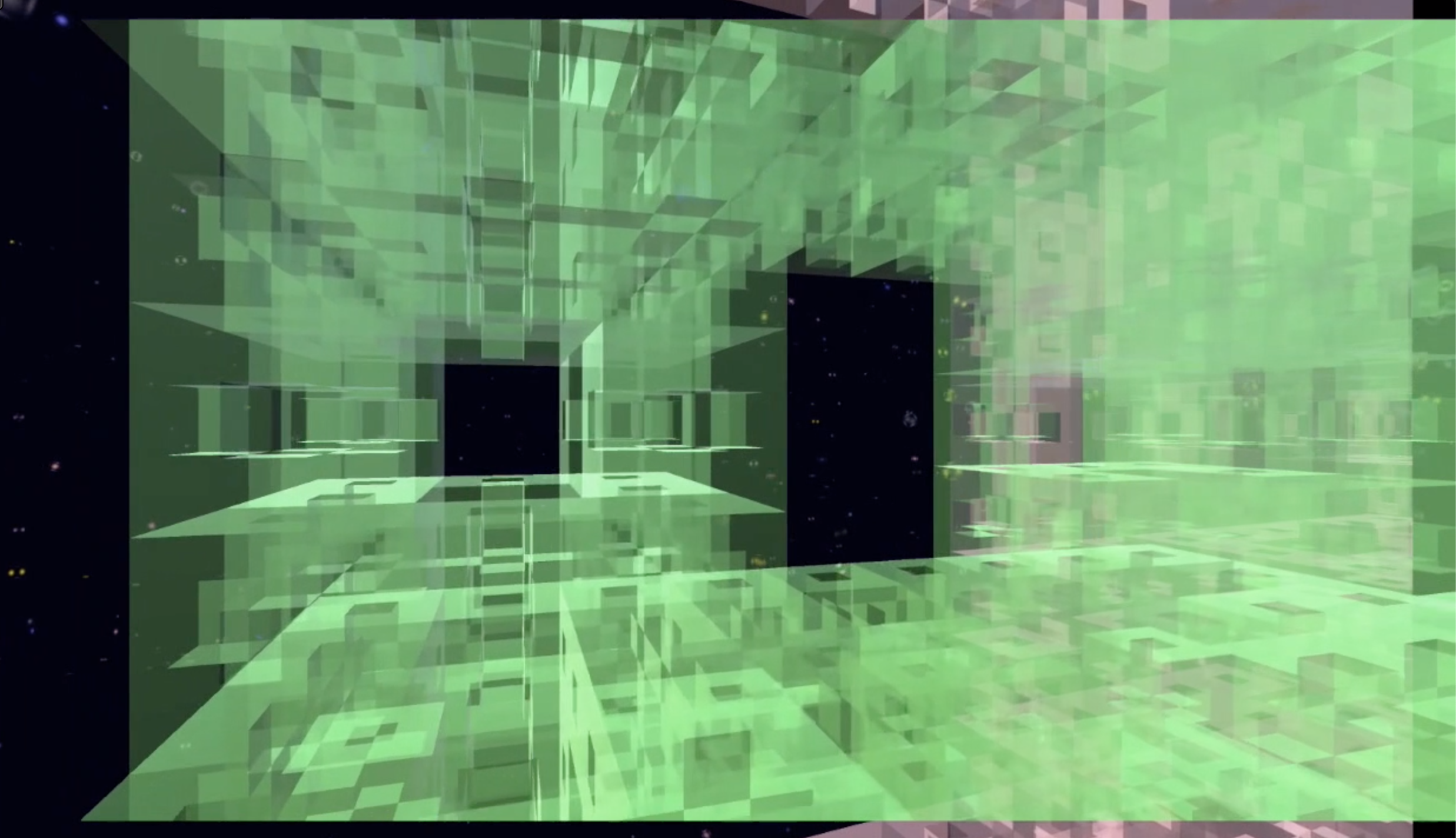 Figures 11 a and b.
Images from Opening Spaces (2019) by Mara Helmuth. (video excerpt – Opening Spaces)
Figures 11 a and b.
Images from Opening Spaces (2019) by Mara Helmuth. (video excerpt – Opening Spaces)
”우주” 작품들: 자연과 떨어진 혹은 자연에서?
처음에 우주에 대한 추상적인 아이디어에 기반한 일부 나의 작품들은 환경적인 음악과는 거의 반대 입장의 것으로 보인다. 우주는 물론 지구와 떨어져 있지만 자연을 바라보는 우주적 관점에서 보면 그렇지 않다.
“성운의 용” (Helmuth 2020)은 1992년 걸프전에 대응한 작품으로, 은하계 성운의 이미지를 연상시켰다. “지구의 날을 위한 노래”에서 사용했던 것과 동일한 그래뉼러 합성 악기를 사용하였으나, 보다 정확히 만들어진 그래뉼러의 움직임과 몇 개의 “금속성의” 사운드 (꽉 들어찬 주파수 영역에 길게 지속되는 소리조각들), 서로 다르게 세분화된 시끄러운 소리덩어리들을 사용하였다. 이런 소리가 자연과는 별 관계가 없는 것처럼 보일 수 있겠지만, 부드럽게 하행하는 소음의 소리 덩어리로 시작하면 바람소리와 닮은 프레이즈를 만들 수 있고, 금속 타악기 사운드로 사나우면서 “메탈릭한” 용의 몸짓을 표현할 수도 있다. 오르내리는 확률을 바탕으로 기복이 생기거나 뒤틀리는 형태의 소리를 만들어 물이나 구름의 모양새를 재현할 수 있다.
“팽창하는 우주”는 튜바와 컴퓨터로 연주되는 작품으로, 디지털 시대에 사람들 간 공간이 증가하고 있다는 개념과 천문학적으로 우주가 팽창하고 있다는 사실에 기반하여, 나의 동료이자 튜바주자인 티모시 노스컷을 위한 곡이다. 다시 말해, 원래의 아이디어는 지구상 생명은 우주와 동떨어져 있고 장황하게 알고리듬으로 혼합된 세번째와 마지막 섹션은 다른 세계에 온 듯한 느낌을 주지만, 10초간의 잔향효과를 가미한 신시내티 주차장에서 녹음한 F튜바와 C튜바의 장엄한 음향이 이 작품을 지구상의 맥락에 머물도록 만들어버렸다.
“열린 공간”은 멩거 스폰지 프랙탈을 기반으로 하여 블렌더와 유나이티를 영상으로 구현한 작품으로, 이번 서울국제컴퓨터음악제에서 곧 선보이게 된다. 그 구성은 관객이 프랙탈의 다양한 버전과 부분사이를 이동할수록 복잡해지는, 공간에 의존한 구조를 가진다. 컨셉상 꽤 추상적이게 보이지만, 기존의 악기와 간단한 배음률에 쓰이는 헬름호르츠 공명기, 2차원 메시 기기로 이루어진 물리적 모델을 바탕으로 RTcmix 악기 프로그램으로 생성된 소리로 구성된다. 자연의 영향을 받은 또다른 관점의 비디오로는 반짝임이 조각조각 소리에 동시반응하면서 방출되는 입자 시스템이 있다. 원래 지구상에서의 소리와 반대되는 정교하게 쌓아올린 추상적인 구조, 입자들이 각자 나름대로 움직이고, 눈이나 바람에 흩날리는 나무의 씨앗을 연상케하는 것들이 초현실적이면서도 놀랍게도 나를 보살펴주는 듯한 느낌을 주었다.

 그림 11 a와 b.
마라 헬무트의 “열린 공간” (2019)의 이미지. (비디오 발췌분)
그림 11 a와 b.
마라 헬무트의 “열린 공간” (2019)의 이미지. (비디오 발췌분)
Looking Back and Ahead
This overview of my work reveals that attention to nature has frequently brought fresh insights and materials into my music. When reaching into the natural world I have not been disappointed by the creative paths that have opened before me. I think this is because I intuitively un-derstand how to relate to places on this earth. I am at-tuned to my home planet sounds, textures, skies, and bodies of water. Its life forms may seem exotic at times, but because they exist on earth, discovering them simply expands the knowledge of the story of our lives, the net-works of life in each niche of each ecosystem. Each trip has broadened my knowledge and experience of not only human cultures, but the context in which humans live, the other species which they eat, fear, avoid, enjoy or revere, and the earth’s structures making up the surrounding natural world.
Conservationist Rachel Carson writes in A sense of Won-der, “There is symbolic as well as actual beauty in the mi-gration of the birds, the ebb and flow of the tides, the folded bud ready for the spring. There is something infi-nitely healing in the repeated refrains of nature – the assurance that dawn comes after night, and spring after the winter.” Humans have evolved with these ecological rhythms and their patterns provide rich materials for art.
In my work, for each new bird call sample, there are hun-dreds of granular processings, or other transformations, a few of which might complete an expressive family of sounds for a piece. For every stochastic process, there are countless potential tweaks of the algorithm which will expand the sound world in new directions. For some of these sounds, it will be immediately apparent how to em-ploy them musically, while others will remain mysterious until I learn to understand their meaning, based on what I know from the natural and human-created world.
My original question, “Can Computer Music Save the Earth?” may best be answered by turning the question around: “Can the Earth Save Computer Music?” Over and over again I find I have drawn inspiration from natural sounds, data, concepts and algorithms. My most extended collaborative relationship is with nature. The sounds and scientific processes of earth inform, sustain, and enlight-en me in the composing process. These practices are an opportunity for focusing collective energy toward sustain-ing our earth environment.
Acknowledgments. My collaborators, mentors and friends have included Brad Garton, Doug Scott, and John Gibson in the RTcmix world, Pauline Oliveros and the deep listeners, Judy Klein, and Esther Lamneck. I would like to thank my teachers, colleagues, students and my family. I am also grateful for the opportunity to share my music and ideas in this KEAMS conference. Finally I want to express my appreciation for this beautiful earth, un-describably diverse, complex and exquisitely nurturing.
앞뒤를 살펴봄
내 작품들을 개괄해보니 그동안 자연에 주목했던 것이 빈번히 내게 새로운 통찰력과 신선한 소재를 마련해주었다고 여겨진다. 자연의 세계에 도달하는 그 어떤 때이건 내 앞에 펼쳐진 창조적인 계획들에 실망한 적이 없었다. 나는 그 이유가 직관적으로 지구 위 공간과 어떻게 관계를 맺어야 하는지 이해하고 있기 때문이라고 생각한다. 나는 나의 고향행성의 소리와 짜임새, 하늘, 강과 바다에 맞춰져 있다. 생명체들이 이따금 달라보일수도 있겠지만, 그들은 지구에 존재하기 때문에, 그들을 발견하는 것은 단순히 우리 삶의 이야기, 각 생태계의 면면에 있는 삶의 네트워크를 확장시키는 것에 불과하다. 내가 한 각각의 여행이 인간 문화뿐 아니라 인간의 삶, 그들이 먹고 두려워하고 피하거나 즐기고 숭배하는 다른 종들, 그리고 주위 자연의 세계를 만들어낸 지구의 구성까지, 그 맥락에 대한 나의 지식과 경험을 넓혀주었다.
환경보호론자인 레이철 카슨은 “경이로움”에서 다음과 같이 썼는데, “새의 이동, 밀물과 썰물, 봄을 준비하며 접힌 꽃봉오리는 상징적이면서도 사실적인 아름다움이 있다. 밤이 가면 새벽이 오고 겨울이 가면 봄이 온다는 확신과 같이, 자연의 반복되는 후렴구에는 무한히 치유해주는 어떤 것이 있다.” 인간은 이러한 생태적 리듬에 맞춰 진화했으며 그 패턴은 예술을 위해 풍성한 재료를 준다.
내 작품에는, 각 새로운 새울음 샘플마다 수백가지의 그래뉼러 처리나 기타 변형과정이 있으며, 몇몇은 한 곡만의 사운드 표현 모음집을 낼 수 있을 정도이다. 모든 확률적 처리과정에는, 알고리듬의 셀수없이 많은 잠재적인 변동이 있게 되고, 이가 새로운 방향의 소리 세계를 열어준다. 이런 소리 중 일부는, 음악적으로 어떻게 사용해야할지 즉시 명백히 알 수 있는 것도 있고, 다른 일부는 자연과 인간이 창조한 세상으로부터 배운 것을 바탕으로 그 의미를 이해하게 될 때까지 비밀스러운 상태에 있기도 할 것이다.
나의 첫 질문, “컴퓨터음악이 지구를 지킬 수 있을까?”는 질문을 되돌림으로써 최상의 대답이 될지도 모른다: “지구가 컴퓨터음악을 구할 수 있을까?” 나는 자연의 소리와 데이터, 개념, 알고리듬으로부터 영감을 얻어왔음을 재차 여러 번 깨달았다. 내게 최고의 협력관계에 자연이 놓여 있었다. 내가 작곡을 할 때, 이 땅의 모든 소리와 과학적 처리과정이 내게 정보를 주고, 지속시키며, 일깨워준다. 이러한 실행이 우리의 지구 환경을 유지하는데 집단적 힘을 집중시킬 기회가 될 것이다.
감사의 말. 나의 협력자이자 멘토, 친구로, RTcmix 세계의 브래드 가르톤, 도그 스캇, 존 깁손, 그리고 폴린 올리베로스와 좋은 청취자들, 주디 클라인과 에스더 램넥이 있다. 나의 선생님과 동료, 학생들, 가족에게 감사한다. 또한 나의 음악과 아이디어들을 공유할 기회를 준 한국전자음악협회에도 감사한다. 마지막으로, 말로 다 할 수 없을 만큼 다양하고 복잡하며 세심하게 보살펴주는 이 아름다운 지구에도 감사를 표하고 싶다.
References
Cage, J. (1981). For the Birds: John Cage in Conversation with Daniel Charles. . London: Boyars.
Hires, B. (2021). U.S. Fish and Wildlife Service Proposes Delist-ing 23 Species from the Endangered Species Act Due to Extinction. In U.S. Fish and Wildlife Service. https://www.fws.gov/news/ShowNews.cfm?ref=u.s.-fish-and-wildlife-service-proposes-delisting-23-species-from-&_ID=37017 Retrieved September 29, 2021.
Fountain, H. (2021). 5 takeaways from the major new U.N. climate report. In New York Times. August 9. New York. Retrieved September 28, 2021.
Helmuth, M. (2007). Abandoned Lake in Maine. In Sound Collaborations. CDCM computer music series 36. CRC 2903. The composer in the computer age. XI. [CD]. Baton Rouge. LA: Centaur Records.
Helmuth, M. (2001). Loonspace. In Implements of Actuation, EMF 023 [CD]. Electronic Music Foundation.
Helmuth, M. (2020). Dragon of the Nebula. [streaming audio]. Soundcloud audio. 8:34. Posted Dec, 2020.
https://soundcloud.com/marahelmuth/dragon-of-the-nebula?si=877de992685248b0a572497206f80189
참고자료
Helmuth, M. (2019). Sound Dunes. In Sound and Video Anthology, Women in Computer Music. 43:4. [online down-loadable audio]. Cambridge, MA: MIT Press.
Ingram, D. (2006). The Clutter of the Unkempt Forest: John Cage, Music and American Environmental Thought. In Amerikastudien/ American Studies 51/4: 567-570. Location: Universitätsverlag WINTER Gmbh.
https://www.jstor.org/stable/41158263 Retrieved October 3, 2021.
Jones, P. (2020). Monet’s Terrifying Light. In Inside the Exhibition 846. Chicago: Art Institute of Chicago.
https://www.artic.edu/articles/846/monets-terrifying-light
Retrieved September 28, 2021.
Rueb, E. (2019). To Reduce Hospital Noise, Researchers Create Alarms That Whistle and Sing. In New York Times. July 9, 2019. New York. Retrieved October 2, 2021.
Wilder, T. (1938). Our Town. New York: Coward-McCann in cooperation with S. French.
논문투고일: 2021년 10월08일
논문심사일: 2021년 11월30일
게재확정일: 2021년 12월02일
